Sophomore(PSAT(
Training(Packet(
(
2016-17(
(
(
(
(
(
(
Math(Department((
Answer(Key(
( (

PSAT/NMSQT
®
Practice Test #1
Answer
Explanations
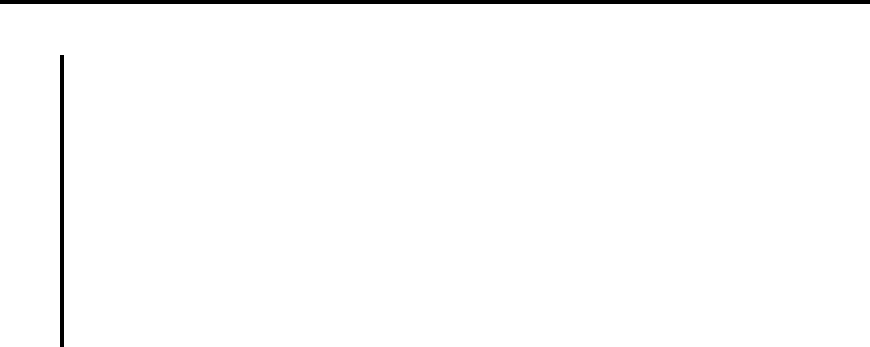
PSAT/NMSQT Practice Test #1 Math Test – No Calculator Answer Explanations
Math Test – No Calculator Answer
Explanations
Question 1
A babysitter earns $8 an hour for babysitting 2 children and an additional
$3 tip when both children are put to bed on time. If the babysitter gets the
children to bed on time, what expression could be used to determine how
much the babysitter earned?
A) 8x + 3, where x is the number of hours
B) 3x + 8, where x is the number of hours
C) x(8 + 2) + 3, where x is the number of children
D) 3x + (8 + 2), where x is the number of children
Item Difficulty: Easy
Content: Heart of Algebra
Correct Answer: A
Choice A is the correct answer. Let
x be the number of hours that the babysitter
worked. Since the babysitter earns money at a rate of
$8 per hour, she earned
8
x dollars for the x hours worked. If the babysitter gets both children to bed on
time, the babysitter earns an additional
$3 tip. Therefore, the babysitter earned a
total amount of
8x + 3 dollars.
Choice B is incorrect since the tip and the rate per hour have been interchanged in
the expression. Choices C and D are incorrect since the number of children is not
part of how the babysitter’s earnings are calculated.
Page 52
M1
M1
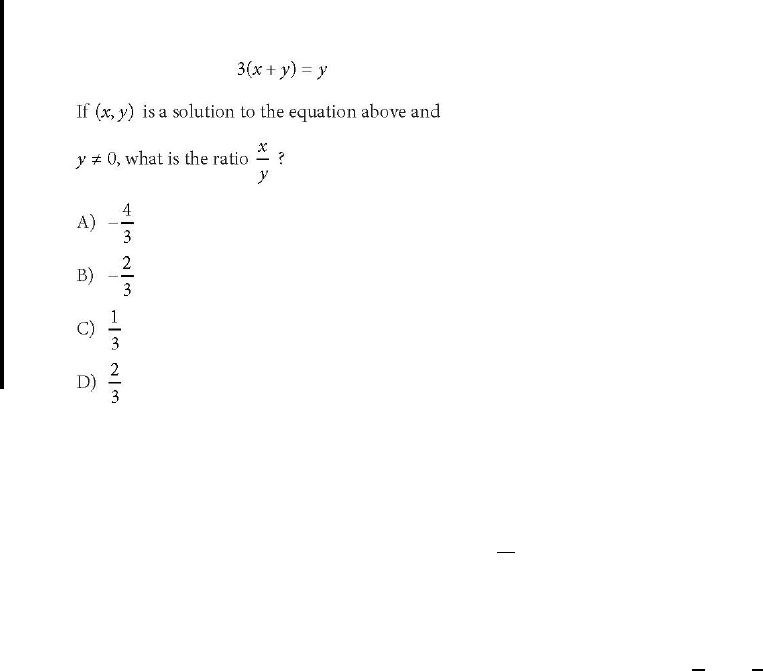
PSAT/NMSQT Practice Test #1 Math Test – No Calculator Answer Explanations
Question 2
Item Difficulty: Medium
Content: Passport to Advanced Math
Correct Answer: B
Choice B is the correct answer. We can find the ratio
x
y
by rearranging the
equation. Multiplying out the expression on the left side of the equation yields
3x + 3y = y. Then, subtracting
3y
from both sides of the equation gives
=−32.xy
Finally, dividing both sides of this equation by
3y (note that y ≠ 0) gives
= −
Choices A, C, and D are incorrect; they could result from errors during algebraic
transformations of the equation
(
)
3.xy y+=
Page 53
M1
M1
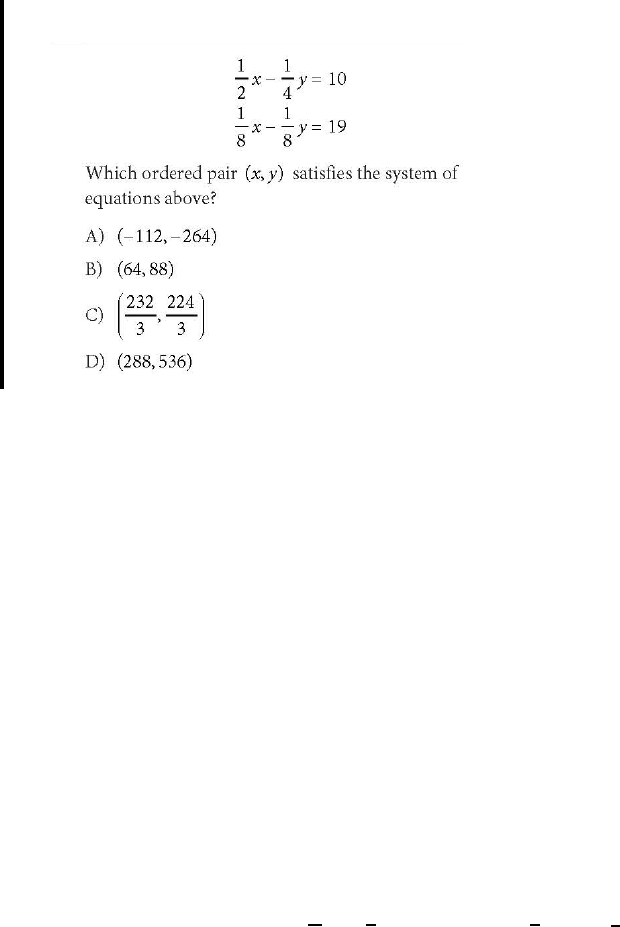
PSAT/NMSQT Practice Test #1 Math Test – No Calculator Answer Explanations
Question 3
Item Difficulty: Medium
Content: Heart of Algebra
Correct Answer: A
Choice A is the correct answer. First, we clear the fractions from the two given
equations by multiplying both sides of the first equation by 4 and then both sides
of the second equation by 8 (note that the new equations are equivalent to the
original ones). Thus the system becomes
{
2 40
.
152
xy
xy
-=
-=
Subtracting side by side
the second equation from the first eliminates the variable
y,
(2x –y) – (x – y) = 40 – 152, leaving an equation with just one variable, x. Solving this
equation gives
x = −112. Substituting −112 for x into the equation x – y = 152 gives
y = −264. Therefore, (−112, −264) is the ordered pair that satisfies the system of
equations given.
Choices B, C, and D are incorrect since the ordered pair in each choice does not
satisfy both equations in the system. For example, the ordered pair of choice B,
(64, 88), does not satisfy equation
= 19 because
(64)
(88) ≠ 19.
Page 54
M1
M1
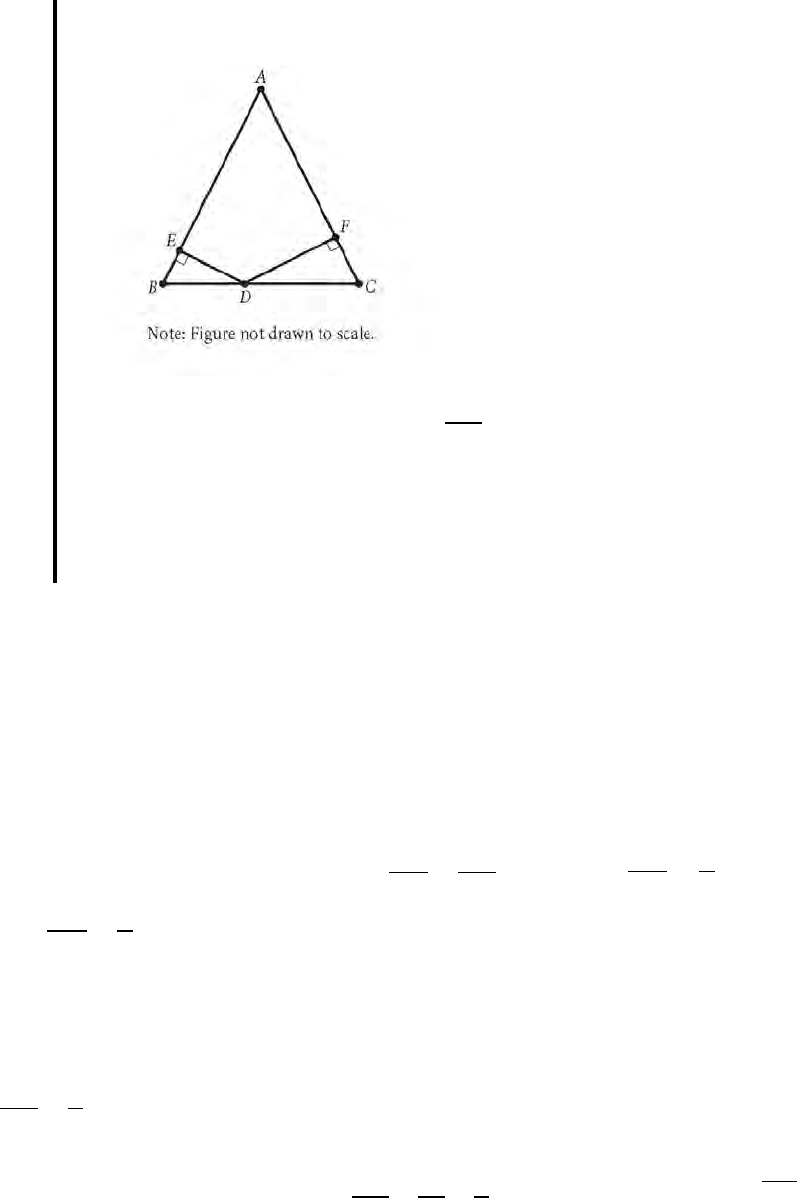
PSAT/NMSQT Practice Test #1 Math Test – No Calculator Answer Explanations
Question 4
Triangle ABC above is isosceles with AB = AC and BC = 48. The ratio of
DE to DF is 5 : 7. What is the length of DC ?
A) 12
B) 20
C) 24
D) 28
5
Item Difficulty: Medium
Content: Additional Topic in Math
Correct Answer: D
Choice D is the correct answer. The base angles,
B and C, of isosceles triangle
ABC are congruent. Additionally, are both right angles and therefore are
congruent. Because
and have two corresponding pairs of angles that
are congruent, they are similar. Consequently, the corresponding sides of the
similar triangles are proportional. So
,
BD DE
DC DF
=
and since
5
7
DE
DF
=
, it follows
that
5
.
7
BD
DC
=
If we let BD = 5x, then DC = 7x. Since
BD + DC = BC and BC = 48, it follows that 5x + 7x = 48. Solving this equation for x
gives x = 4, and so DC is 7(4) = 28.
Alternatively: Due to the similarity of
and , one can conclude that
5
,
7
BD
DC
=
and so DC must be greater than half of BC, which is 24. Of the choices
given, only one satisfies this condition, namely
28. If DC = 28, then
BD = 48 – 28 = 20, confirming that
20 5
.
28 7
BD
DC
==
Therefore, the length of
DC
must be
28.
Page 55
M1
M1

PSAT/NMSQT Practice Test #1 Math Test – No Calculator Answer Explanations
Choices A, B, and C are incorrect because each of the values for
DC would result in
BC being less than 48 units long.
Question 5
5
In a certain game, a player can solve easy or hard puzzles. A player earns
30 points for solving an easy puzzle and 60 points for solving a hard
puzzle. Tina solved a total of 50 puzzles playing this game, earning 1,950
points in all. How many hard puzzles did Tina solve?
A) 10
B) 15
C) 25
D) 35
Item Difficulty: Medium
Content: Heart of Algebra
Correct Answer: B
Choice B is the correct answer. Let
x and y be the number of easy and hard
puzzles, respectively, that Tina solved. Since she solved a total of
50 puzzles, it
follows that
x + y = 50. She earned a total of 1,950 points, so it must also be true
that
30x + 60y = 1,950. Dividing both sides of this equation by 30 gives x + 2y = 65.
Subtracting the first equation,
x + y = 50, from the second equation, x + 2y = 65,
gives
y = 15. Therefore, Tina solved 15 hard puzzles.
Alternatively: Let x be the number of easy puzzles Tina solved. Then,
50 − x is the
number of hard puzzles she solved. And since she earned a total of
1,950 points, it
must be true that
30x + 60(50 – x) = 1,950. Solving this equation for x gives
x = 35, and so 50 – x = 15. Therefore, Tina solved 15 hard puzzles.
Choices A and C are incorrect because if the number of hard puzzles Tina solved
were as they indicate, the total number of points she would earn will not be
1,950.
The incorrect answer in choice D could be the result of interchanging the number
of hard puzzles and easy puzzles.
Page 56
M1
M1
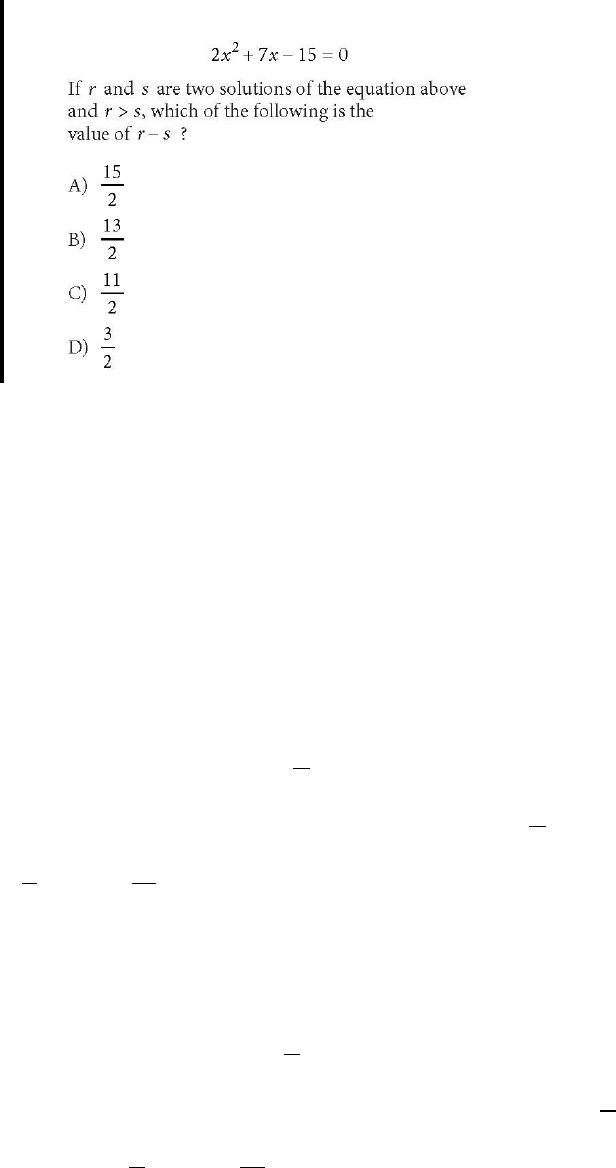
PSAT/NMSQT Practice Test #1 Math Test – No Calculator Answer Explanations
Question 6
Item Difficulty: Medium
Content: Passport to Advanced Math
Correct Answer: B
Choice B is correct. This equation can be solved using the quadratic formula or
factoring. The quadratic formula approach is left as an exercise for students. We
will show first how to solve this equation using simple factoring and then will
show how to solve it using both the structure of the equation and factoring.
Since
7x = 10x – 3x, the given equation can be rewritten as 2x
2
+ (10x – 3x) – 15 = 0.
Regrouping the terms so that the left side of the equation is in the factored form
gives
(2x – 3)(x + 5) = 0, from which it follows that 2x – 3 = 0 or x + 5 = 0. Thus, the
quadratic equation has solutions
3
2
and
5-
. Since r and s are solutions to the
quadratic equation and
rs>
, we can conclude that
3
2
r =
and
5s =-
; therefore,
3 13
(5)
22
rs-=--=
.
Alternatively: Multiplying the original equation by 2, we can rewrite it in terms of
2x as follows: (2x)
2
+ 7(2x) – 30 = 0. Since the two numbers whose sum is –7 and
whose product is
–30 are –10 and 3, the equation will be factored as
(
)
(
)
2 – 3 2 10 0xx+=
, generating
3
2
and −5 as solutions. Since r and s are solutions
to the quadratic equation and
rs>
, we can conclude that
3
2
r =
and s = −5;
therefore,
3 13
(5)
22
rs-=--=
.
Choices A, C, and D are incorrect and could result from calculating the value of
expressions given in terms of the solutions
r and s, but are not equivalent to the
Page 57
M1
M1

PSAT/NMSQT Practice Test #1 Math Test – No Calculator Answer Explanations
difference
r – s of these solutions. For example,
15
2
is the value of −rs, not the
value of
r – s.
Question 7
To cut a lawn, Allan charges a fee of $15 for his equipment and $8.50 per
hour spent cutting a lawn. Taylor charges a fee of $12 for his equipment
and $9.25 per hour spent cutting a lawn. If x represents the number of
hours spent cutting a lawn, what are all the values of x for which Taylor’s
total charge is greater than Allan’s total charge?
A) x > 4
B) 3 ≤ x ≤ 4
C) 4 ≤ x ≤ 5
D) x < 3
Item Difficulty: Medium
Content: Heart of Algebra
Correct Answer: A
Choice A is the correct answer. If
x represents the number of hours spent cutting
the lawn, the total fee that Allan charges is
8.5 15x +
dollars and the total fee that
Taylor charges is
9.25 12x +
dollars. To find all of the values of x for which Taylor’s
total fee is greater than Allan’s total fee, we solve the inequality
9.25 12 8.5 15,xx+> +
which simplifies to
0.75 3,x >
and so
4x >
.
Alternatively: Since Taylor’s hourly rate charge is higher than Allan’s, it can be
concluded that after a certain amount of hours, Taylor’s total charge will always be
greater than Allan’s total charge. Thus the inequality that represents all possible
values of
x for which this occurs will be of the form x > a for some value a. Of the
choices given, only
x > 4 is in this form. Lastly, one can confirm that Taylor and
Allan charge the same amount when
x = 4. Therefore, choice A is correct.
Choice B is incorrect because Allan’s total charge is greater than Taylor’s total
charge when
4.x <
Choice C is incorrect because Allan’s total charge and
Taylor’s total charge at
4x =
are exactly the same, and Taylor’s total charge is
greater than Allan’s total charge also for values of
x greater than 5. Choice D is
incorrect because Allan’s total charge is greater than Taylor’s charge when
x is less
than
3.
Page 58
M1
M1

PSAT/NMSQT Practice Test #1 Math Test – No Calculator Answer Explanations
Question 8
n = 456 − 3T
The equation above is used to model the relationship between the number
of cups, n, of hot chocolate sold per day in a coffee shop and the average
daily temperature, T, in degrees Fahrenheit. According to the model, what
is the meaning of the 3 in the equation?
A) For every increase of 3°F, one more cup of hot chocolate will be sold.
B) For every decrease of 3°F, one more cup of hot chocolate will be sold.
C) For every increase of 1°F, three more cups of hot chocolate will be sold.
D) For every decrease of 1°F, three more cups of hot chocolate will be sold.
Item Difficulty: Medium
Content: Heart of Algebra
Correct Answer: D
Choice D is the correct answer. According to the model, if the average daily
temperature is
T degrees Fahrenheit, then the number of cups of hot chocolate
sold per day in the coffee shop would be
456 − 3T. If the temperature decreases by
1°F, then the number of cups of hot chocolate sold per day in the coffee shop
would be
456 − 3(T − 1), which can be rewritten as (456 − 3T) + 3. Therefore, for
every
1°F drop in the average daily temperature, the coffee shop sells three more
cups of hot chocolate.
Choices A and B are incorrect because the change in the average daily
temperature and the change in the number of cups of hot chocolate have been
interchanged. Choice C is incorrect because, according to the model, the higher
value of daily temperature corresponds to a lower, not higher, number of cups of
hot chocolate sold.
Page 59
M1
M1
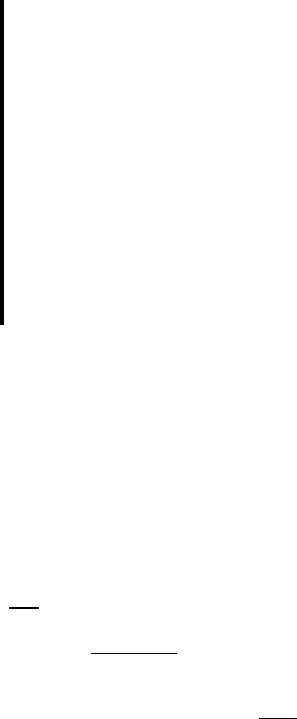
PSAT/NMSQT Practice Test #1 Math Test – No Calculator Answer Explanations
Question 9
A truck enters a stretch of road that drops 4 meters in elevation for every
100 meters along the length of the road. The road is at 1,300 meters
elevation where the truck entered, and the truck is traveling at 16 meters
per second along the road. What is the elevation of the road, in meters, at
the point where the truck passes t seconds after entering the road?
A) 1,300 − 0.04t
B) 1,300 − 0.64t
C) 1,300 − 4t
D) 1,300 − 16t
Item Difficulty: Medium
Content: Heart of Algebra
Best Answer: B
Choice B is the correct answer. Since the truck is traveling at
16 meters per second
along the road, the distance it has traveled t seconds after entering the road is
16t
meters. Since the elevation of the road drops 4 meters for every 100 meters along
the length of the road, it follows that for
16t meters along the road, the elevation
drops
x 16 or 0.64t. Therefore, the elevation of the road at the point where the
truck passes t seconds after entering the road is
1,300 – 0.64t meters.
Choice A is incorrect because
4
100
t
would be the number of meters that the
elevation drops t seconds after the truck enters the road if its speed were
1 meter
per second. Choice C is incorrect because
4t meters does not give the number of
meters the elevation of the road drops. Choice D is incorrect because the drop rate
of
4 meters for every 100 meters along the road is not used.
Page 60
M1
M1
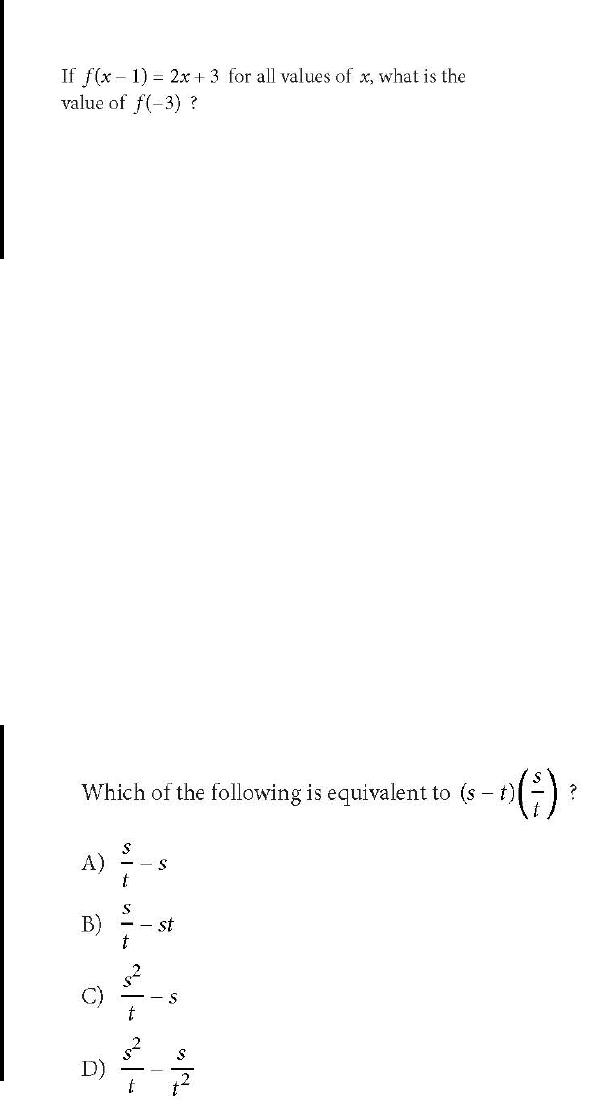
PSAT/NMSQT Practice Test #1 Math Test – No Calculator Answer Explanations
Question 10
A) −7
B) −5
C) −3
D) −1
Item Difficulty: Medium
Content: Passport to Advanced Math
Correct Answer: D
Choice D is correct. Since
f(x – 1) = 2x + 3 for all values of x,
f(−3) = f(−2 – 1) = 2(−2) + 3 and so the value of f(−3) is −1.
Alternatively:
2x + 3 can be rewritten as 2(x – 1) + 5 and since f(x – 1) = 2(x – 1) + 5
for all values of
x, it follows that f(x) = 2x + 5 for all values of x. Substituting −3 for x
in this equation gives
f(−3) = 2(−3) + 5 = –1.
Choices A, B, and C are incorrect because f is a function, and there is one and only
one value for
f(−3), which as shown above is −1. Therefore, neither of the choices,
−7, −5, or −4 can be the value of f(−3).
Question 11
Item Difficulty: Medium
Content: Passport to Advanced Math
Correct Answer: C
Page 61
M1
M1
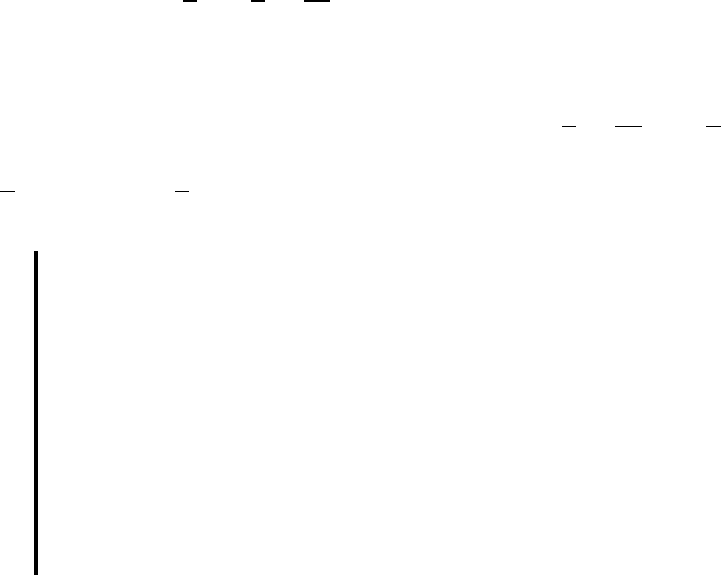
PSAT/NMSQT Practice Test #1 Math Test – No Calculator Answer Explanations
Choice C is the correct answer. Using the distributive property to expand the given
expression gives
(
)
(
)
2
sss
st s
ttt
-=-
.
Choices A, B, and D are incorrect. In each of these choices, at least one of the
products in the expansion is not correct. For example
(
)
2
ss
s
tt
=
, not
,
s
t
and
(
)
s
ts
t
=
, not st or
.
s
t
Question 12
p(x) = 3(x
2
+ 10x + 5) − 5(x − k)
In the polynomial p(x) defined above, k is a constant. If p(x) is divisible by
x, what is the value of k?
A) −3
B) −2
C) 0
D) 3
Item Difficulty: Medium
Content: Passport to Advanced Math
Correct Answer: A
Choice A is the correct answer. If polynomial
p(x) is divisible by x, then x must be a
factor of the polynomial, or equivalently, the constant term of the polynomial must
be zero. Multiplying out on the right side of the equation gives
p(x) = 3x
2
+ 30x + 15 − 5x + 5k, which can be rewritten as p(x) = 3x
2
+ 25x + (5k + 15).
Hence,
5k + 15 = 0, and so k = −3.
Choices B, C, and D are the not correct answers because if the value of
k were as
indicated in those choices, then
x would not be a factor of the polynomial p(x), and
so
p(x) would not be divisible by x.
Page 62
M1
M1
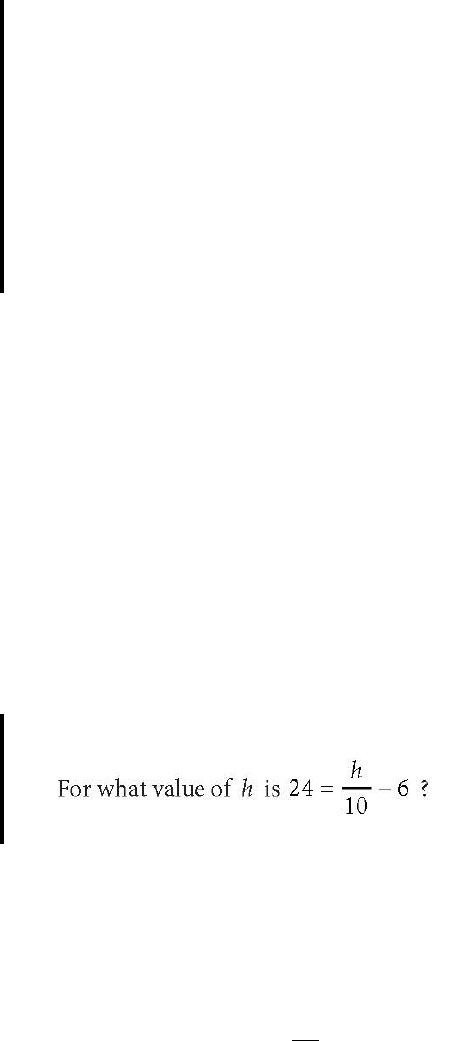
PSAT/NMSQT Practice Test #1 Math Test – No Calculator Answer Explanations
Question 13
In the xy-plane, if the parabola with equation y = ax2 + bx + c, where a, b,
and c are constants, passes through the point (−1, 1), which of the
following must be true?
A) a − b = 1
B) −b + c = 1
C) a + b + c = 1
D) a − b + c = 1
Item Difficulty: Hard
Content: Passport to Advanced Math
Correct Answer: D
Choice D is the correct answer. If the graph of a parabola passes through the point
(
−1, 1), then the ordered pair (−1, 1) must satisfy the equation of the parabola.
Thus,
(
)
(
)
2
11 1,abc=- +-+
which is equivalent to
1.abc-+=
Choices A, B, and C are incorrect and could result from misinterpreting what it
means for the point (–1, 1) to be on the parabola or from common calculation
errors while expressing this fact algebraically.
These are the directions students will see in the test for the Student-Produced
Response questions.
Question 14
Item Difficulty: Easy
Content: Heart of Algebra
Correct Answer: 300
The correct answer is 300. To solve the given equation for
h, first add 6 to both
sides of the equation to get
30
10
h
=
. Then multiply both sides of this equation by
10 to yield h = 300.
Page 63
M1
M1
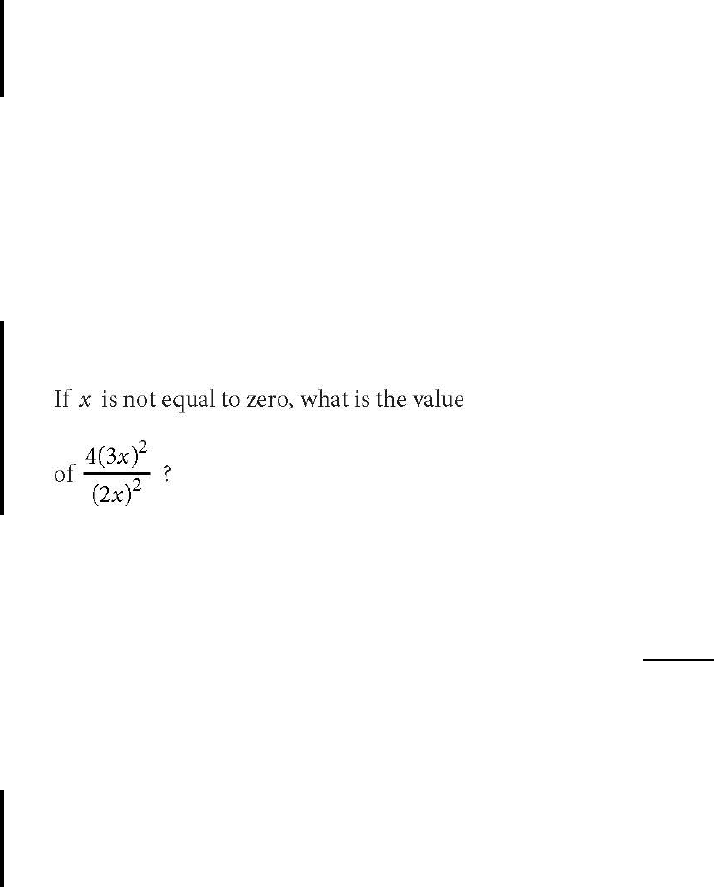
PSAT/NMSQT Practice Test #1 Math Test – No Calculator Answer Explanations
Question 15
What is the value of a if (2a + 3) − (4a − 8) = 7 ?
Item Difficulty: Medium
Content: Heart of Algebra
Correct Answer: 2
The correct answer is 2. The equation given can be rewritten as
2a + 3 – 4a + 8 = 7,
which is equivalent to
–2a + 11 = 7, and so a = 2.
Question 16
Item Difficulty: Medium
Content: Passport to Advanced Math
Correct Answer: 9
The correct answer is 9. Multiplying out the given expression gives
2
2
4(9 )
.
4
x
x
Since
x ≠ 0, dividing both the numerator and the denominator of the fraction by
2
4x
simplifies the expression to 9.
Question 17
If x − 2 is a factor of x
2
− bx + b, where b is a constant, what is the value of
b ?
Item Difficulty: Hard
Content: Passport to Advanced Math
Correct Answer: 4
The correct answer is
4. If x – 2 is a factor of x
2
– bx + b, where b is a constant, then
x
2
– bx + b can be written as the product (x – 2)(x – a) for some real number a.
Expanding
(x – 2)(x – a) gives x
2
– 2x – ax+ 2a, which can be rewritten as
x
2
– (2 + a)x + 2a. Hence, x
2
– (2 + a)x + 2a = x
2
– bx + b is true for all values of x.
Consequently, the coefficients of like terms on each side of the equation must be
the same:
2 + a = b and 2a = b. Solving this system gives
4.b =
Page 64
M1
M1
PSAT/NMSQT Practice Test #1 Math Test – No Calculator Answer Explanations
Alternatively: Since
x – 2 is a factor of x
2
– bx + b and (x – 2)
2
= x
2
– 4x + 4,one can
correctly conclude that the value of
b is 4.
Page 65
M1
M1
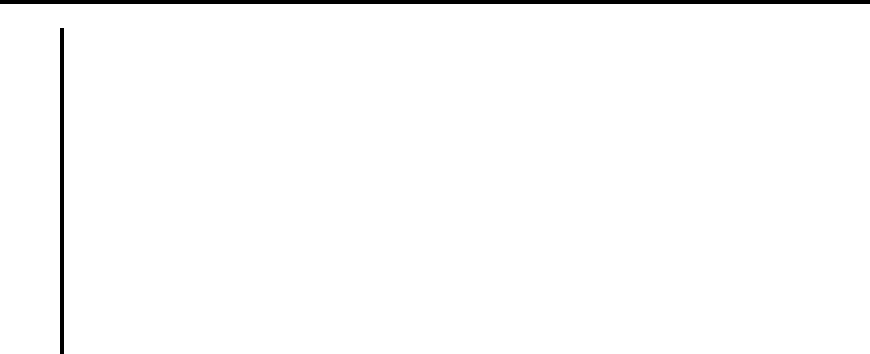
PSAT/NMSQT Practice Test #1 Math Test – Calculator Answer Explanations
Math Test – Calculator Answer Explanations
Question 1
Tyra subscribes to an online gaming service that charges a monthly fee of
$5.00 and $0.25 per hour for time spent playing premium games. Which of
the following functions gives Tyra’s cost, in dollars, for a month in which
she spends x hours playing premium games?
A) C(x) = 5.25x
B) C(x) = 5x + 0.25
C) C(x) = 5 + 0.25x
D) C(x) = 5 + 25x
Item Difficulty: Easy
Content: Heart of Algebra
Correct Answer: C
Choice C is the correct answer. Tyra pays
$0.25 per hour for time spent playing
premium games, so for the month in which she spends
x hours playing premium
games, she pays
0.25x dollars for playing the premium games. She also pays an
additional
$5 monthly fee. Therefore, Tyra’s cost, in dollars, for the month in which
she spends
x hours playing premium games is given by the function
C(x) = 5 + 0.25x.
Choice A is incorrect because Tyra is not charged
$5.25 per hour for time playing
premium games. Choice B is incorrect because the charge per hour has been
interchanged with the monthly fee. Choice D is incorrect because
25x is the charge
for playing premium games in cents, not in dollars.
Page 66
M2
M2
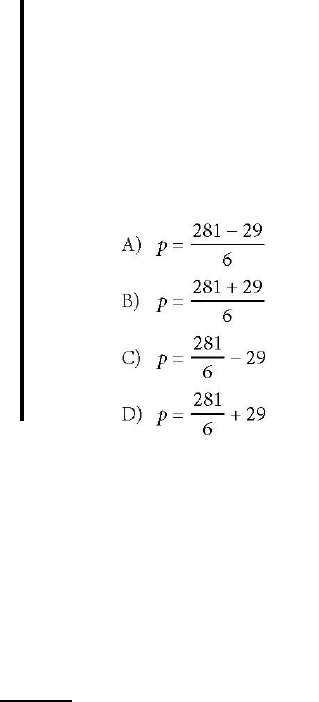
PSAT/NMSQT Practice Test #1 Math Test – Calculator Answer Explanations
Question 2
A grocery store sells a brand of juice in individual bottles and in packs of 6
bottles. On a certain day, the store sold a total of 281 bottles of the brand
of juice, of which 29 were sold as individual bottles. Which equation shows
the number of packs of bottles, p, sold that day?
Item Difficulty: Easy
Content: Heart of Algebra
Correct Answer: A
Choice A is the correct answer. Since the store sold a total of
281 bottles, 29 of
which were sold individually, it follows that
281 – 29 bottles were sold in packs of 6
bottles. Therefore, the number of packs of bottles,
p, sold that day in the store is
p =
.
Choice B is incorrect. Adding the number of bottles sold individually,
29, to the
total number of bottles sold,
281, does not give the number of bottles that were
sold in packs of
6. Choices C and D are incorrect and could result from dividing all
of the bottles into groups of
6 (incorrectly assuming that all 281 bottles of juice
were sold in packs of
6), and either subtracting the 29 bottles sold individually from
that result, as in choice C, or adding the
29 bottles to that result, as in choice D.
Page 67
M2
M2
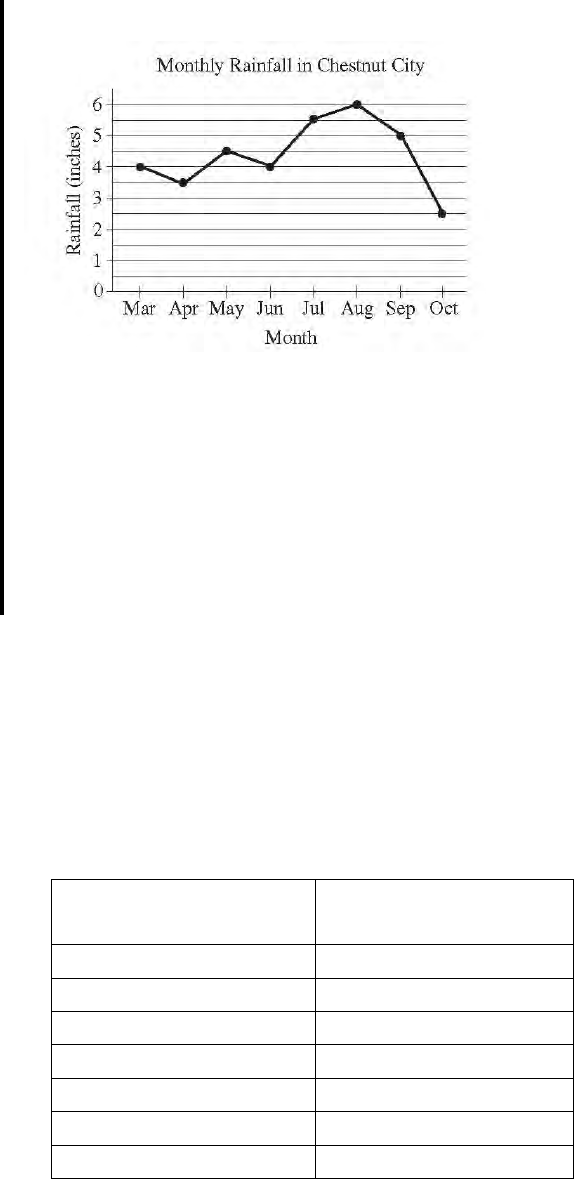
PSAT/NMSQT Practice Test #1 Math Test – Calculator Answer Explanations
Question 3
The line graph above shows the monthly rainfall from March to October
last year in Chestnut City. According to the graph, what was the greatest
change (in absolute value) in the monthly rainfall between two consecutive
months?
A) 1.5 inches
B) 2.0 inches
C) 2.5 inches
D) 3.5 inches
Item Difficulty: Medium
Content: Probability and Data Analysis
Correct Answer: C
Choice C is the correct answer. The greatest change (in absolute value) in monthly
rainfall could be an increase or a decrease in monthly rainfall. The table below
shows the approximate changes in monthly rainfall in Chestnut City last year
between each of the two consecutive months.
Consecutive months
Change in monthly
rainfall (inches)
March to April
0.5
April to May
1
May to June
0.5
June to July
1.5
July to August
0.5
August to September
1
September to October
2.5
Of the values on the right column, the greatest is from September to October,
which is a change of
2.5 inches.
Page 68
M2
M2
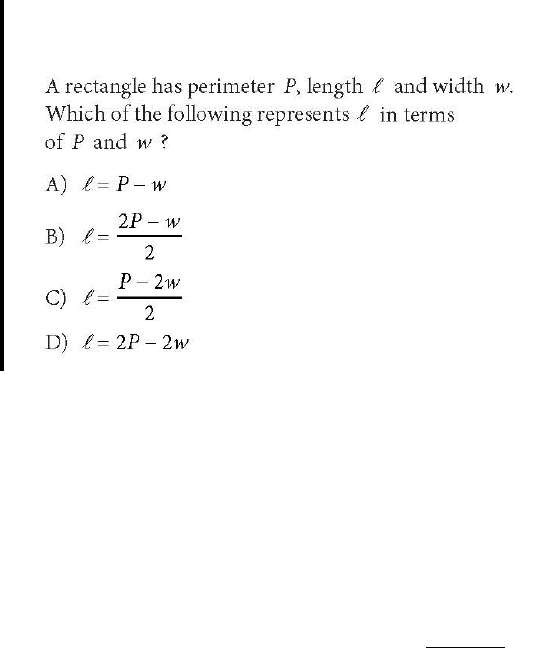
PSAT/NMSQT Practice Test #1 Math Test – Calculator Answer Explanations
Choices A, B, and D are incorrect because they contain values that either do not
represent any of the changes in monthly rainfall between two consecutive months
or that are not the greatest change.
Question 4
Item Difficulty: Medium
Content: Passport to Advanced Math
Correct Answer: C
Choice C is the correct answer. The perimeter of a rectangle is the sum of the four
sides and can be calculated using the formula
P = 2
+ 2w, where
is the length
and w is the width of the rectangle. Subtracting 2w from both sides of the equation
gives
P – 2w = 2
, and then dividing by 2 yields
=
2
2
Pw-
.
Choice A is incorrect. This choice does not use the fact that the perimeter of a
rectangle is the sum of two length and two widths. Choice B and D are incorrect. In
each of these choices, the equation incorrectly doubles the perimeter.
Page 69
M2
M2
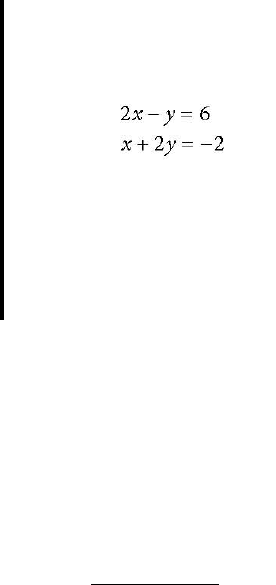
PSAT/NMSQT Practice Test #1 Math Test – Calculator Answer Explanations
Question 5
Which ordered pair (x, y) satisfies the system of equations shown below?
A) (−6, 2)
B) (−2, 2)
C) (2, −2)
D) (4, 2)
Item Difficulty: Medium
Content: Heart of Algebra
Correct Answer: C
Choice C is the correct answer. To eliminate
y, the first equation in the system can
be multiplied by
2 and then the equations can be added as shown below.
4 – 2 12
2 –2
5 0 10
xy
xy
x
=
+=
+=
Since the result is 5x = 10, it follows that x = 2. Substituting 2 for x into the equation
x + 2y = −2 gives 2 + 2y = −2 and so y = –2. Therefore, (2, –2) is the solution to the
system given.
Alternatively: Use the substitution method to solve the system. For example, the
first equation can be rewritten as
y = 2x – 6. Substituting 2x – 6 for y in the second
equation gives
x + 2(2x – 6) = –2, and so x = 2. Finally, substituting 2 for x in y = 2x – 6
gives y = –2, leading to the same solution of the system, namely (2, –2).
Choice B is incorrect. The value for x and the value for y have been reversed in the
ordered pair. Choices A and D are incorrect. The ordered pair in each of these
choices does not satisfy at least one of the equations in the system. For example,
the ordered pair
(4, 2) does not satisfy the equation x + 2 = –2, since 4 + 2(2) ≠ −2.
Page 70
M2
M2
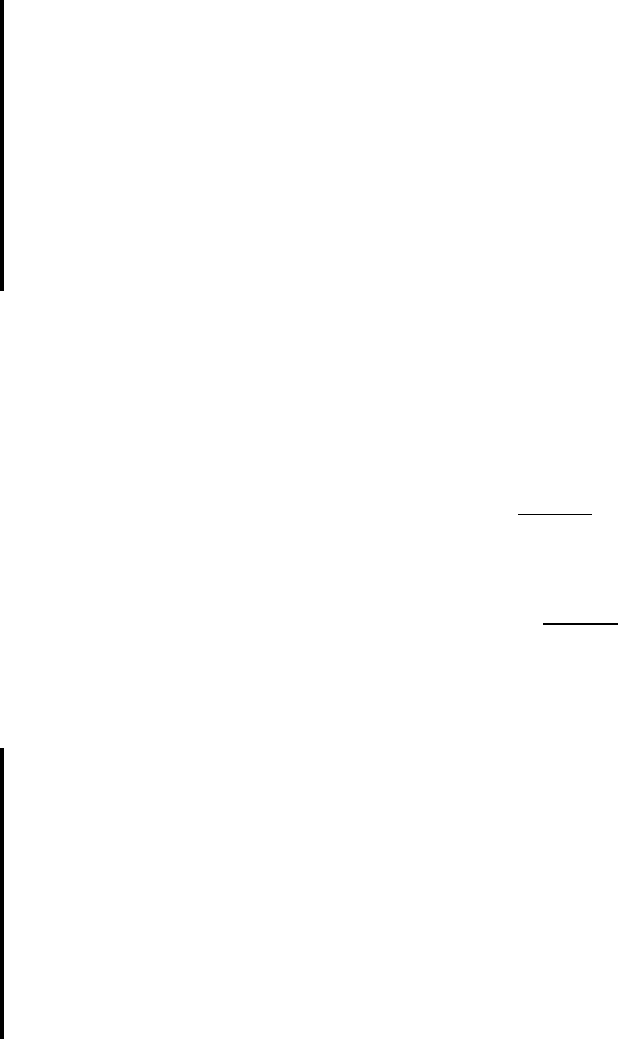
PSAT/NMSQT Practice Test #1 Math Test – Calculator Answer Explanations
Question 6
A soda company is filling bottles of soda from a tank that contains 500
gallons of soda. At most, how many 20-ounce bottles can be filled from the
tank? (1 gallon = 128 ounces)
A) 25
B) 78
C) 2,560
D) 3,200
Item Difficulty: Easy
Content: Probability and Data Analysis
Correct Answer: D
Choice D is the correct answer. Since 1 gallon equals 128 ounces, 500 gallons
equal
(500)(128) = 64,000 ounces. Therefore, the maximum number of 20-ounce
bottles that can be filled with the soda from the tank is
64,000
3, 200.
20
=
Choice A is incorrect and could result from dividing 500 (the number of gallons
contained in the tank) by
20 (the capacity of one bottle, in ounces). The gallons
need to be converted into ounces first, and then the result can be divided by 20.
Choices B and C are incorrect because they do not give the maximum number of
20-ounce bottles that can be filled from the soda in the tank.
Question 7
A car traveled at an average speed of 80 miles per hour for 3 hours and
consumed fuel at a rate of 34 miles per gallon. Approximately how many
gallons of fuel did the car use for the entire 3-hour trip?
A) 2
B) 3
C) 6
D) 7
Item Difficulty: Medium
Content: Probability and Data Analysis
Correct Answer: D
Choice D is the correct answer. Since the car traveled at an average speed of
80
miles per hour, the distance the car traveled during
3 hours is (80)(3) = 240 miles.
Page 71
M2
M2
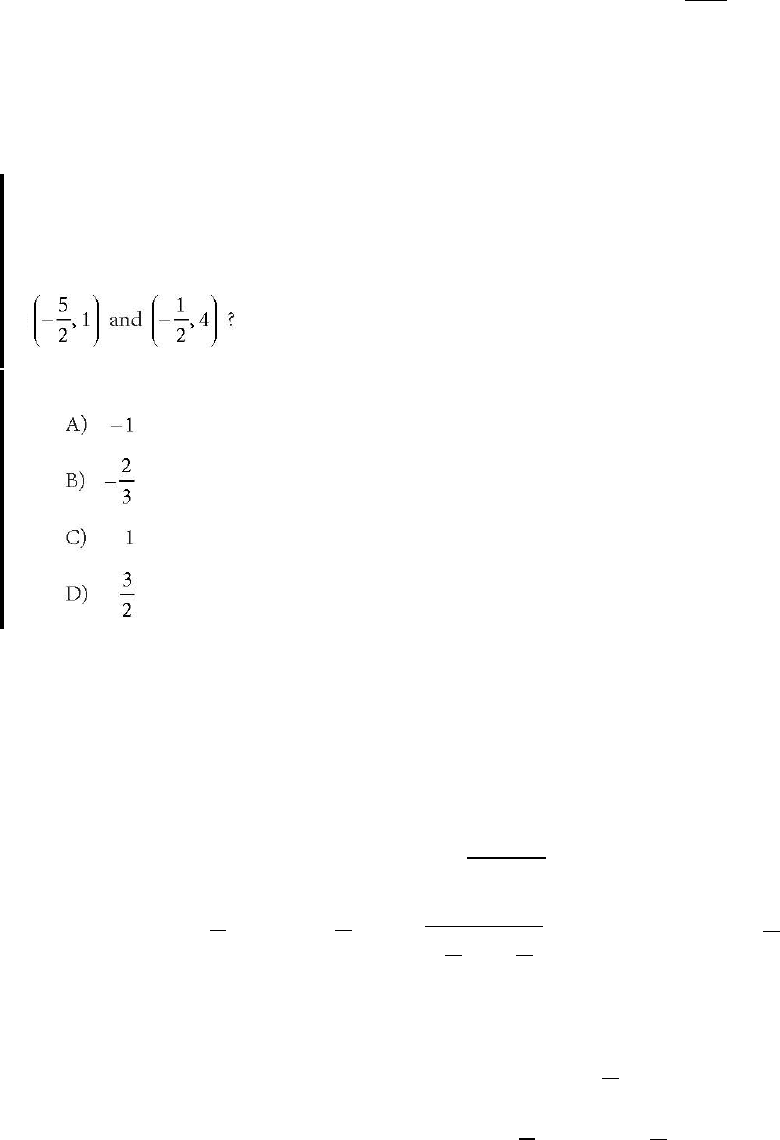
PSAT/NMSQT Practice Test #1 Math Test – Calculator Answer Explanations
The car consumed fuel at a rate of
34 miles per gallon, so the car used
240
34
gallons of fuel, which is approximately 7 gallons of fuel.
Choices A, B, and C are incorrect. For each of these choices, the amount of fuel is
not enough to travel the entire
240 miles.
Question 8
What is the slope of the line in the xy-plane that passes through the points
Item Difficulty: Medium
Content: Heart of Algebra
Correct Answer: D
Choice D is the correct answer. In the
xy-plane, the slope m of a line that passes
through the points
(x
1,
y
1
) and (x
2,
y
2
) is the change in y over the change in x (rise
over run), which is expressed by the formula
21
21
.
yy
m
xx
-
=
-
Thus, the slope of the
line through the points
(
)
5
,1
2
-
and
(
)
1
,4
2
-
is
(
)
41
,
15
22
-
---
which simplifies to
3
.
2
Choices A and C are incorrect because the change in
y and the change in x do not
have the same magnitude. Choice B is incorrect; the fraction
2
3
-
is the negative
reciprocal of the slope of the line through the points
(
)
5
,1
2
-
and
(
)
1
,4 .
2
-
Page 72
M2
M2
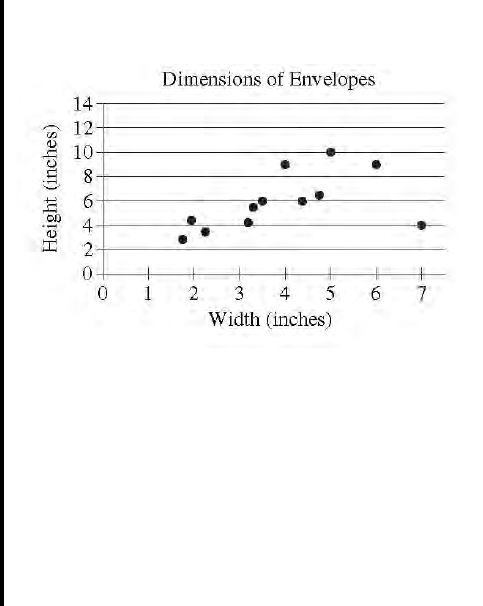
PSAT/NMSQT Practice Test #1 Math Test – Calculator Answer Explanations
Question 9
The scatterplot above shows the widths and the heights of 12 types of
rectangular envelopes. What is the width, in inches, of the envelope
represented by the data point that is farthest from the line of best fit (not
shown)?
A) 2
B) 5
C) 7
D) 12
Item Difficulty: Medium
Content: Probability and Data Analysis
Correct Answer: C
Choice C is the correct answer. The data point that is farthest from the line of best
fit is located at (
7, 4), which means that this point represents a type of envelope
that is
7 inches wide and 4 inches high.
Choices A and B are incorrect because none of the data points with width
2 or
width
5 is the farthest from the line of best fit. Choice D is incorrect because the
scatterplot does not contain any points with width
12 inches.
Page 73
M2
M2
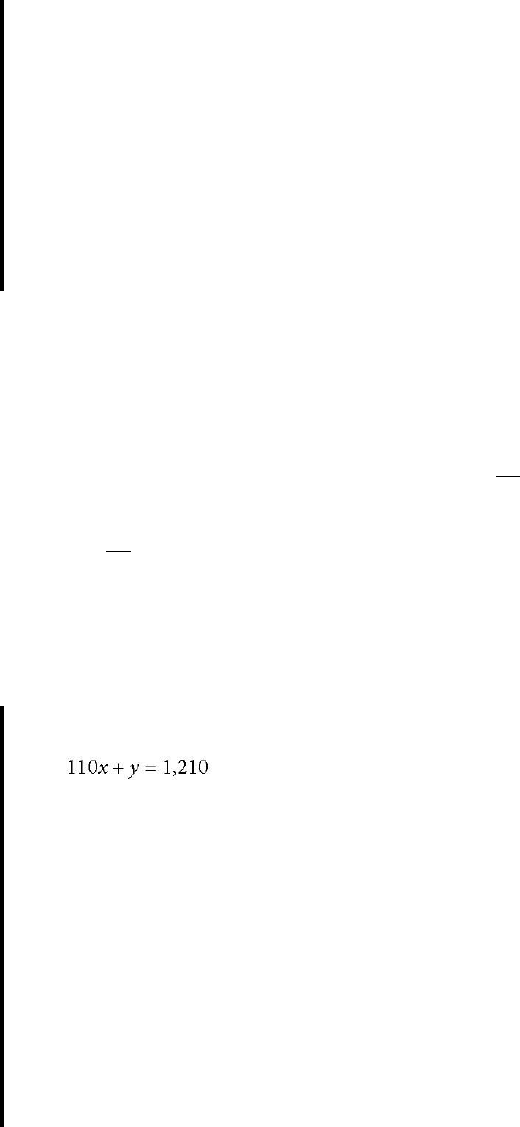
PSAT/NMSQT Practice Test #1 Math Test – Calculator Answer Explanations
Question 10
A high school basketball team won exactly 65 percent of the games it
played during last season. Which of the following could be the total
number of games the team played last season?
A) 22
B) 20
C) 18
D) 14
Item Difficulty: Medium
Content: Probability and Data Analysis
Correct Answer: B
Choice B is the correct answer. The number of games won by the basketball team
must be a whole number. Since
65% is equivalent to
13
,
20
it follows that, of the
choices given, the total number of games the team played last season can only be
20.Multiplying
13
20
by each of the other answer choices does not result in a whole
number.
Choices A, C, and D are incorrect because 65% of each of the numbers in the
choices results in non-whole numbers.
Question 11
A coffee shop is running a promotion where a number of free coffee
samples are given away each day. The equation above can be used to
model the number of free coffee samples, y, that remain to be given away x
days after the promotion began. What does it mean that (11, 0) is a
solution to this equation?
A) During the promotion, 11 samples are given away each day.
B) It takes 11 days during the promotion to see 1,210 customers.
C) It takes 11 days during the promotion until none of the samples are
remaining.
D) There are 11 samples available at the start of the promotion.
Item Difficulty: Medium
Content: Heart of Algebra
Correct Answer: C
Page 74
M2
M2
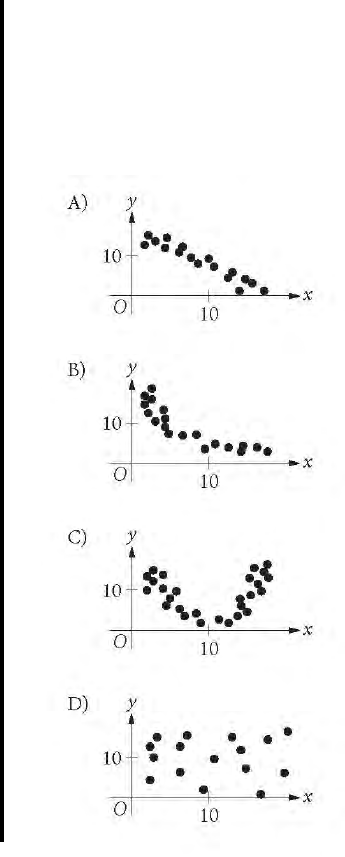
PSAT/NMSQT Practice Test #1 Math Test – Calculator Answer Explanations
Choice C is the correct answer. Since
x represents the number of days after the
promotion began and
y represents the remaining number of coffee samples, the
fact that the ordered pair (
11, 0) is a solution to the given equation means that it
takes
11 days during the promotion until none of the samples are remaining.
Choice A is incorrect; if
11 samples were given away each day, then the coefficient
of
x in the equation would be 11. Therefore, this is not the correct interpretation of
(11, 0) as a solution to the equation. Choice B is incorrect; the total number of free
coffee samples given away during
11 days of the promotion was 1,210. But the
number of customers who were in the store during those days need not be
1,210.
Choice D is incorrect; according to the given equation, there were
1,210, not 11,
samples available at the start of the promotion.
Question 12
Which scatterplot shows a negative association that is not linear? (Note: A
negative association between two variables is one in which higher values of
one variable correspond to lower values of the other variable, and vice
versa.)
Page 75
M2
M2
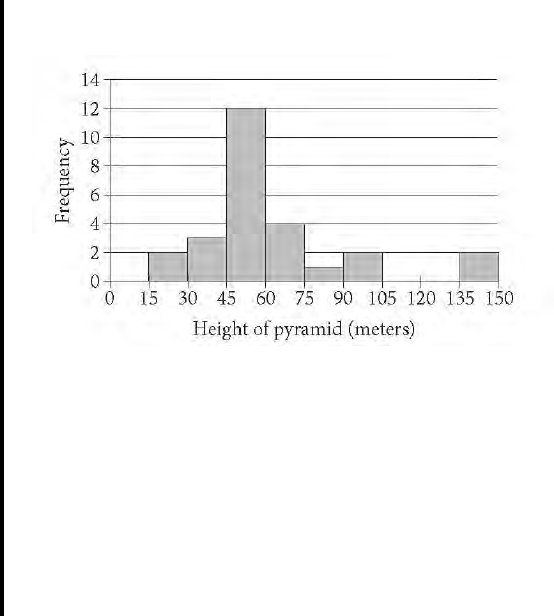
PSAT/NMSQT Practice Test #1 Math Test – Calculator Answer Explanations
Item Difficulty: Medium
Content: Probability and Data Analysis
Correct Answer: B
Choice B is the correct answer. Of the choices given, only the scatterplots in A and
B show a negative association between variables
x and y, and of these two
associations, the one depicted in choice B is not linear.
Choice A is incorrect. The association depicted in this scatterplot is negative, but it
can also be linear. Choice C is incorrect. The association depicted in this
scatterplot is not linear. However, for
x greater than 10, the association between x
and y is positive. Choice D is incorrect. There is no clear association between x and
y in this scatterplot.
Question 13
The histogram above shows the distribution of the heights, in meters, of
26 pyramids in Egypt. Which of the following could be the median height
of the 26 pyramids represented in the histogram?
A) 44 meters
B) 48 meters
C) 63 meters
D) 77 meters
Item Difficulty: Medium
Content: Probability and Data Analysis
Correct Answer: B
Choice B is the correct answer. The median of a data set is the middle value when
the data points are sorted in either ascending or descending order. When the
number of the data points is even, then the median is the mean of the two middle
values of the sorted data. Hence, the median height of the
26 pyramids is the mean
Page 76
M2
M2
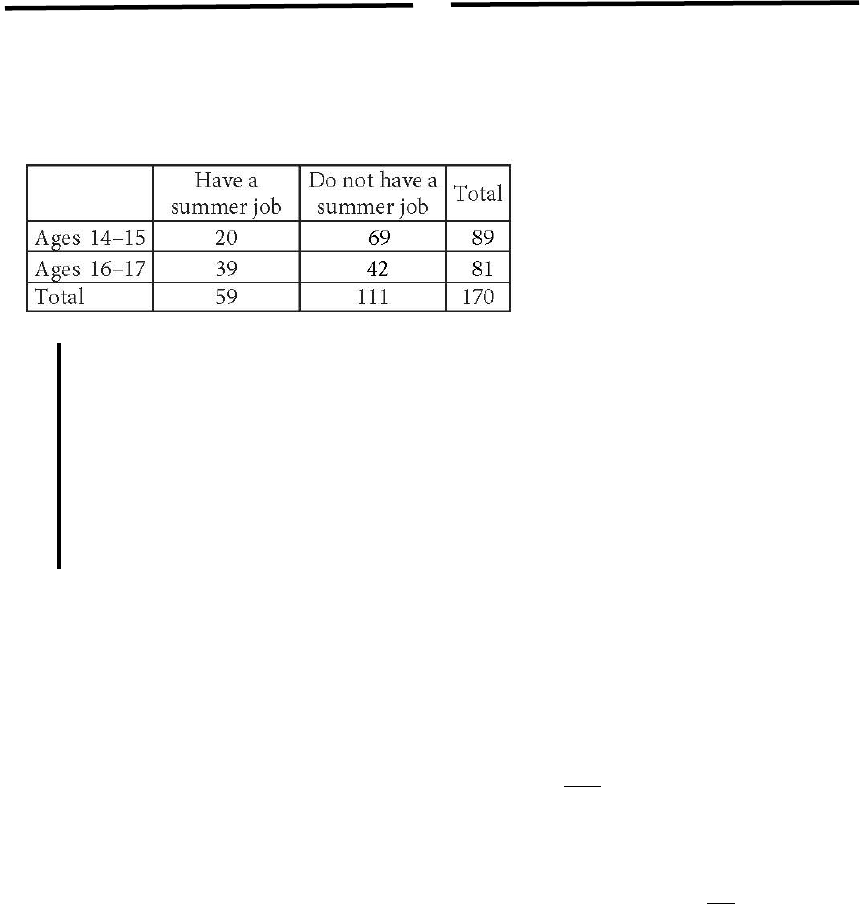
PSAT/NMSQT Practice Test #1 Math Test – Calculator Answer Explanations
of the
13th and 14th tallest pyramids. Since the number of pyramids that are less
than
30 meters high is 5 and the number of pyramids that are less than 60 meters
high is
17, the median height of the 26 pyramids must be between 45 and 60
meters. Therefore, of the choices given, only
48 meters could be the median height
of the
26 pyramids.
Choices A, C, and D are incorrect because the median height of the
26 pyramids
cannot be less than
45 meters or greater than 60 meters.
▼
Questions 14-16 refer to the following information.
A survey of 170 randomly selected teenagers aged 14 through 17 in the United
States was conducted to gather data on summer employment of teenagers. The
data are shown in the table below.
Question 14
Which of the following is closest to the percent of
those surveyed who had a summer job?
A) 22%
B) 35%
C) 47%
D) 53%
Item Difficulty: Medium
Content: Probability and Data Analysis
Correct Answer: B
Choice B is the correct answer. The number of teenagers surveyed in the data is
170. Of those surveyed, a total of 59 teenagers had a summer job; thus, the percent
of those teenager surveyed who had a summer job is
59
0.347,
170
=
which rounds
to
35%.
Choice A is incorrect. This choice,
22%, is the approximate percent
(
)
20
0.22
89
≈
of
teenagers aged
14 to 15 who had summer jobs. But that is not precisely what is
Page 77
M2
M2

PSAT/NMSQT Practice Test #1 Math Test – Calculator Answer Explanations
asked in this question. Choices C and D are incorrect and may be the result of
calculating relative frequencies that are different from what the problem asks.
Question 15
In 2012 the total population of individuals in the United States who were
between 14 and 17 years old (inclusive) was about 17 million. If the survey
results are used to estimate information about summer employment of
teenagers across the country, which of the following is the best estimate of
the total number of individuals between 16 and 17 years old in the United
States who had a summer job in 2012?
A) 8,200,000
B) 3,900,000
C) 2,000,000
D) 390,000
Item Difficulty: Hard
Content: Probability and Data Analysis
Correct Answer: B
Choice B is the correct answer. In
2012, the total population of individuals in the
United States who were between
14 and 17 years old (inclusive) was about 17
million, which is
10
5
times the size of the survey sample, 170. Since of those
surveyed,
39 teenagers aged 16 to 17 had a summer job, it follows that the best
estimate of the total number of individuals aged
16 to 17 in the United States who
had a summer job in
2012 was 39 × 10
5
= 3,900,000.
Choices A, C, and D are incorrect and are likely the result of either conceptual or
calculation errors made.
Question 16
Based on the data, how many times more likely is it for a 14 year old or a
15 year old to NOT have a summer job than it is for a 16 year old or a 17
year old to NOT have a summer job? (Round the answer to the nearest
hundredth.)
A) 0.52 times as likely
B) 0.65 times as likely
C) 1.50 times as likely
D) 1.64 times as likely
Item Difficulty: Hard
Content: Probability and Data Analysis
Correct Answer: C
Page 78
M2
M2
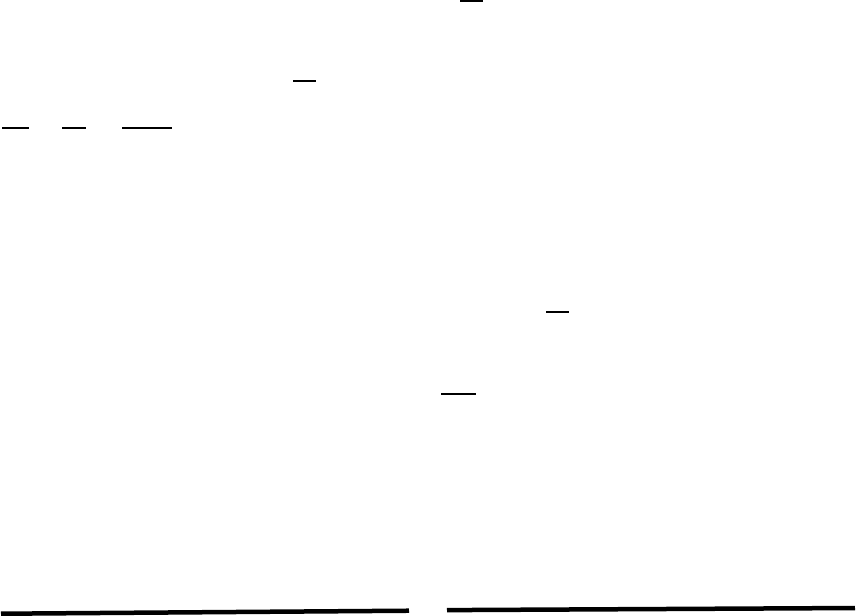
PSAT/NMSQT Practice Test #1 Math Test – Calculator Answer Explanations
Choice C is the correct answer. According to the data shown in the table,
69 out of
89 teenagers aged 14 to 15 did not have summer jobs. So for a 14- or 15-year-old,
the likelihood of not having a summer job is
. And since 42 out of 81 teenagers
aged
16 to 17 did not have a summer job, the likelihood that a 15- or 16-year-old
not having a summer job is
. Therefore, a 14- or 15-year-old is
÷
=
,
,
= 1.49518, or about 1.50, times more likely to not have
a summer job.
Choice A is incorrect. This choice could result from calculating the likelihood that a
teenager aged
16 to 17 will not have a summer job
. Choice B is incorrect.
This choice could result from calculating the likelihood that a teenager aged
14
through
17 will not have a summer job is
. Choice D is incorrect. This choice
could result from calculating the ratio of the number of teenagers aged
14 to 15
who do not have a summer job
(69) to the number of teenagers aged 16 to 17 who
do not have a summer job
(42). If the total number of those surveyed in the two
different groups were the same, this result would be correct. But the sizes of the
two groups are different; therefore, the result obtained is incorrect.
▲
Page 79
M2
M2
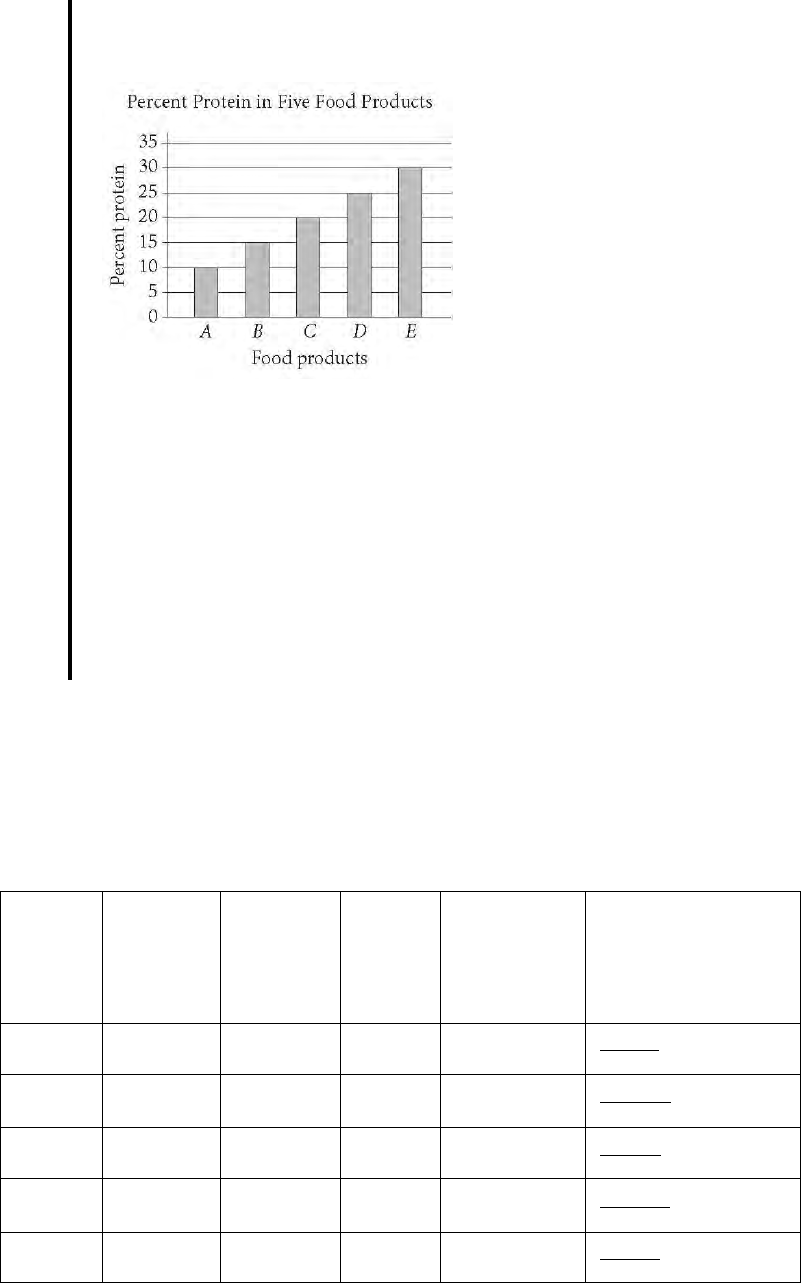
PSAT/NMSQT Practice Test #1 Math Test – Calculator Answer Explanations
Question 17
The graph above shows the amount of protein supplied by five different
food products, A, B, C, D, and E, as a percentage of their total weights.
The costs of 10 grams of products A, B, C, D, and E are $2.00, $2.20, $2.50,
$4.00, and $5.00, respectively. Which of the five food products supplies the
most protein per dollar?
A) A
B) B
C) C
D) E
Item Difficulty: Medium
Content: Probability and Data Analysis
Correct Answer: C
Choice C is the correct answer. The table below organizes the information in the
graph and the additional data needed to answer the question.
Food
product
Cost of
10 grams
of
product
Amount
of
product
(in
grams)
Percent
protein
Amount of
protein
(in grams)
Protein
per dollar
(in grams/dollar)
A
$2.00 10 10% 0.1(10) = 1
10(0.1)
0.5
2
=
B
$2.20 10 15%
0.15(10) =
1.5
10(0.15)
0.68
2.2
=
C
$2.50 10 20% 0.2(10) = 2
10(0.2)
0.8
2.5
=
D
$4.00 10 25%
0.25(10) =
2.5
10(0.25)
0.625
4
=
E
$5.00 10 30% 0.3(10) = 3
10(0.3)
0.6
5
=
Page 80
M2
M2
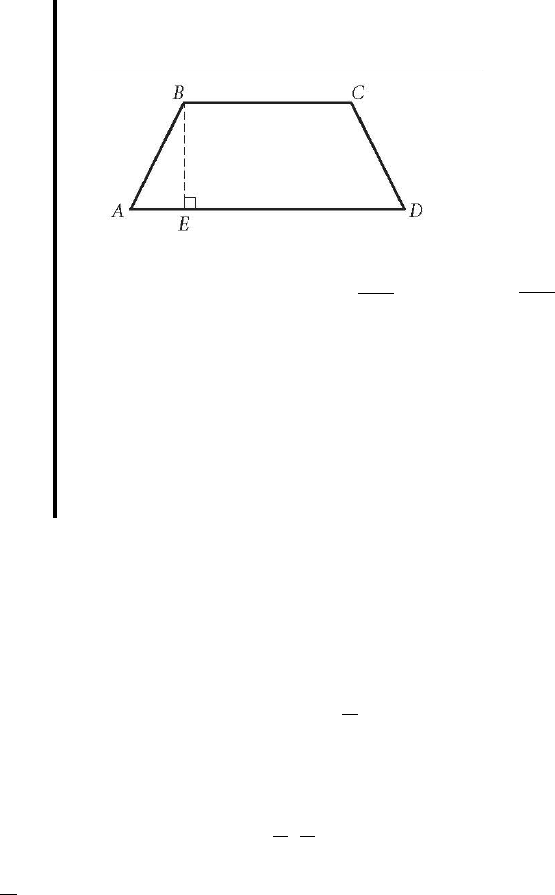
PSAT/NMSQT Practice Test #1 Math Test – Calculator Answer Explanations
According to the table, food product C provides the most protein per dollar
(0.8).
Choices A, B, and D are incorrect. For each choice, the protein per dollar for each
of the food products is less than
0.8 grams of protein per dollar.
Question 18
In quadrilateral ABCD above, BC is parallel to AD, and AB = CD. If BC
and AD were each doubled and BE was reduced by 50 percent, how would
the area of ABCD change?
A) The area of ABCD would be decreased by 50 percent.
B) The area of ABCD would be increased by 50 percent.
C) The area of ABCD would not change.
D) The area of ABCD would be multiplied by 2.
Item Difficulty: Medium
Content: Passport to Advanced Math
Correct Answer: C
Choice C is the correct answer. Quadrilateral
ABCD is a trapezoid, and the formula
for the area of a trapezoid is
12
1
(),
2
Ahbb=+
where
1
b
and
2
b
are the bases of
the trapezoid (
BC and AD) and h is the height (BE). If the bases (BC and AD) are
each doubled and the height (
BE) is reduced by 50%, then the area of the new
trapezoid
ABCD would be
()
12
1
(2 2 ),
22
h
bb+
which after multiplying out becomes
12
1
(),
2
hb b+
the same as the area of the original trapezoid. Therefore, the area of
the trapezoid would not change.
Choice A is incorrect. This choice does not take into account the changes to the
bases,
BC and AD. Choice B is incorrect. This choice could result from incorrectly
interpreting the impact of doubling the bases on the area of
ABCD as a 100%
increase and the impact of reducing the height by
50% as a 50% decrease, resulting
Page 81
M2
M2

PSAT/NMSQT Practice Test #1 Math Test – Calculator Answer Explanations
in a combined
100% − 50% = 50% increase of the area. Choice D is incorrect. This
choice does not take into account the change to height,
BE.
Question 19
Boyd grows only tomatoes and raspberries in his garden. Last year, he
grew 140 pounds of tomatoes and 60 pounds of raspberries. This year, the
production, by weight, of tomatoes declined by 20 percent, and the
production, by weight, of raspberries declined by 50 percent. By what
percentage did the total yield, by weight, of Boyd’s garden decline?
A) 29 percent
B) 30 percent
C) 35 percent
D) 70 percent
Item Difficulty: Hard
Content: Probability and Data Analysis
Correct Answer: A
Choice A is the correct answer. Since Boyd’s production of tomatoes declined by
20% and the production of raspberries declined by 50% from the previous year,
this year, his tomato production was
140 − 0.2(140) = 112 pounds and his raspberry
production was
60 − 0.5(60) = 30 pounds. The percent decline in the total yield is the
decline in the number of pounds of tomatoes and raspberries divided by the
original number of pounds of tomatoes and raspberries, which is
28 30
0.29 29%.
140 60
+
==
+
Choice B is incorrect. This choice is close to the answer, but rounding may have
erroneously led to this answer. Choice C is incorrect. This choice,
35%, may be a
result of calculating the mean of
20% and 50%. Choice D is incorrect. This choice is
the approximate percent weight of the tomatoes and raspberries produced this
year compared to the last year, but that’s not what the problem asks for.
Page 82
M2
M2
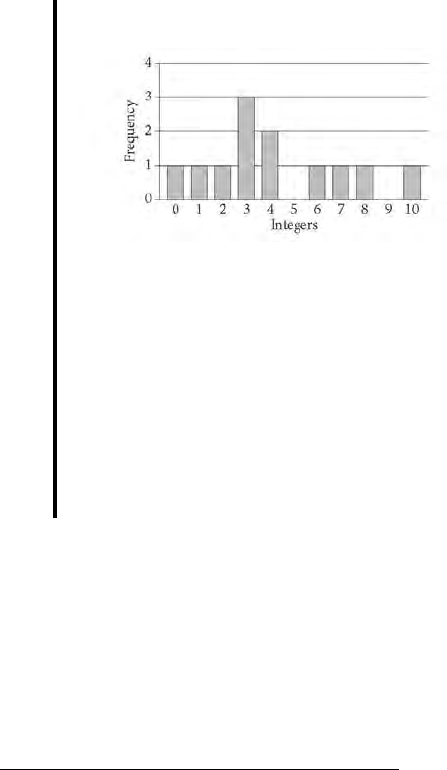
PSAT/NMSQT Practice Test #1 Math Test – Calculator Answer Explanations
Question 20
The graph above shows the frequency distribution of a list of randomly
generated integers between 0 and 10. What is the mean of the list of
numbers?
A) 3.0
B) 3.5
C) 4.25
D) 12.0
Item Difficulty: Medium
Content: Probability and Data Analysis
Correct Answer: C
Choice C is the correct answer. There are
12 integers in the list, and some of them
are repeated at the frequencies shown in the graph. So the mean of the list of
numbers is the sum of the numbers (repeats included) divided by
12. That is
0 1 2 3(3) 2(4) 6 7 8 10
4.25.
12
++ + + + + ++
=
Choice A is incorrect;
3 is the mode, not the mean, of the list of numbers. Choice B
is incorrect;
3.5 is the median, not the mean, of the list of numbers. Choice D is
incorrect;
12 is the total number of the integers in the list.
Page 83
M2
M2
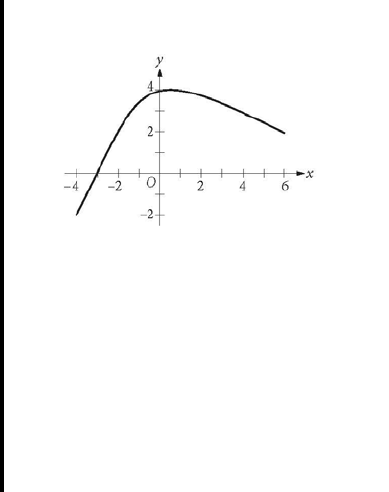
PSAT/NMSQT Practice Test #1 Math Test – Calculator Answer Explanations
Question 21
What is the minimum value of the function graphed on the xy-plane
above, for −4 ≤ x ≤ 6 ?
A) −∞
B) −4
C) −2
D) 1
Item Difficulty: Hard
Content: Passport to Advanced Math
Correct Answer: C
Choice C is the correct answer. The minimum value of a graphed function is the
minimum
y-value of all the points on the graph. For the graph shown, the
minimum is at the left endpoint of the graph, the
y-value of which is −2.
Choice A is incorrect. If the graph would continue indefinitely downward, then the
minimum value of the function would be negative infinity. However, the domain of
the function is restricted
(−4 ≤ x ≤ 6) and the minimum value of the graph occurs at
point (
−4, −2). Choice B is incorrect; −4 is the x-value of the point on the graph
where the minimum value of the function occurs. Choice D is incorrect because
there are points of the graph below the
x-axis; therefore, the minimum value of the
function cannot be positive.
Page 84
M2
M2
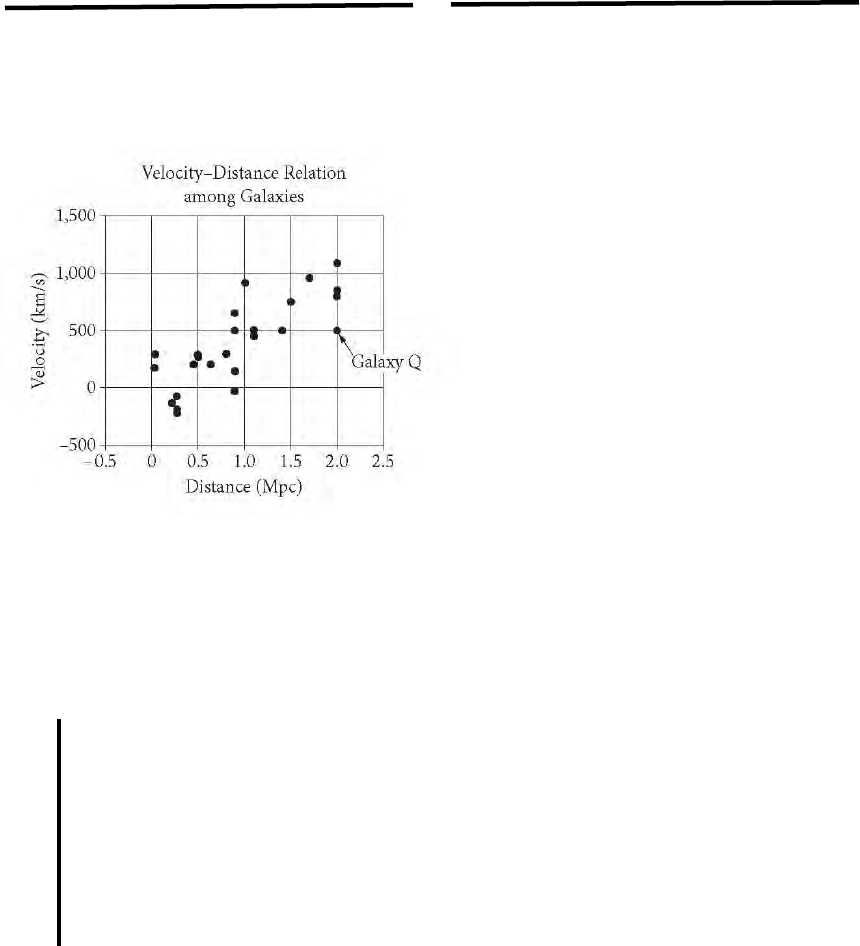
PSAT/NMSQT Practice Test #1 Math Test – Calculator Answer Explanations
▼
Questions 22-24 refer to the following information.
In 1929, the astronomer Edwin Hubble published the data shown. The graph plots
the velocity of galaxies relative to Earth against the distances of galaxies from
Earth.
Hubble’s data can be modeled by the equation
v = 500d, where v is the velocity, in
kilometers per second, at which the galaxy is moving away from Earth and
d is the
distance, in megaparsecs, of the galaxy from Earth. Assume that the relationship is
valid for larger distances than are shown in the graph. (A megaparsec (Mpc) is
3.1 × 10
19
kilometers.)
Question 22
According to Hubble’s data, how fast, in meters per second, is Galaxy Q
moving away from Earth?
A) 2 × 10
6
m/s
B) 5 × 10
5
m/s
C) 5 × 10
2
m/s
D) 2.5 × 10
2
m/s
Item Difficulty: Hard
Content: Probability and Data Analysis
Correct Answer: B
Choice B is the correct answer. The coordinates of the data point that represent
Galaxy Q on the scatterplot are (
2.0, 500), which means that Galaxy Q is at a
distance of about
2.0 Mpc from Earth and moves away from Earth at a velocity of
approximately
500 km/s. The question asks for the velocity in meters per second;
therefore, kilometers (km) need to be converted into meters (m). Since
1 km is
Page 85
M2
M2

PSAT/NMSQT Practice Test #1 Math Test – Calculator Answer Explanations
equal to
1,000 m, it follows that Galaxy Q is moving away from Earth at a velocity
of
500 × 1,000 m/s, or 5 × 10
5
m/s.
Choices A, C, and D are incorrect and may result from an incorrect interpretation of
the coordinates of the point that represents Galaxy Q on the scatterplot or an
incorrect conversion of the units.
Question 23
There are four galaxies shown in the graph at approximately 0.9 Mpc from
Earth. Which of the following is closest to the range of velocities of these
four galaxies, in kilometers per second?
A) 100
B) 200
C) 450
D) 700
Item Difficulty: Hard
Content: Probability and Data Analysis
Correct Answer: D
Choice D is the correct answer. The velocities, in km/s, of the four galaxies shown
in the graph at approximately
0.9 Mpc from Earth are about –50, +200, +500, and
+650. Thus, the range of the four velocities is approximately 650 – (−50) = 700 km/s.
Choices A, B, and C are incorrect. The range of velocities is the difference between
the largest and smallest velocity. Each of the answer choices A, B, and C are too
small compared to the real value of the range.
Question 24
Based on the model, what is the velocity, in kilometers per second, of a
galaxy that is 15 Mpc from Earth?
A) 7,500 km/s
B) 5,000 km/s
C) 1,100 km/s
D) 750 km/s
Item Difficulty: Medium
Content: Heart of Algebra
Correct Answer: A
Choice A is the correct answer. The model indicates that the relationship between
the velocities of the galaxies, in km/s, and their distance from Earth, in Mpc, is
v = 500d. Therefore, the velocity of a galaxy that is 15 Mpc from Earth is v = 500(15)
km/s, or
7,500 km/s.
Page 86
M2
M2
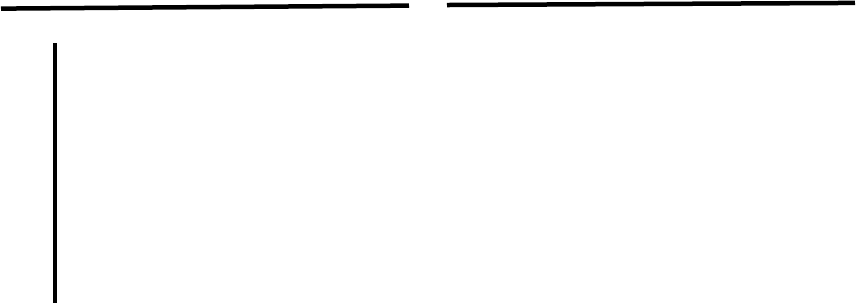
PSAT/NMSQT Practice Test #1 Math Test – Calculator Answer Explanations
Based on the model, the other choices are incorrect: Choice B is the speed of a
galaxy that is
10 Mpc from Earth. Choice C is the speed of a galaxy that is 2.2 Mpc
from Earth. Choice D is the speed of a galaxy that is
1.5 Mpc from Earth.
▲
Question 25
Janice puts a fence around her rectangular garden. The garden has a
length that is 9 feet less than 3 times its width. What is the perimeter of
Janice’s fence if the area of her garden is 5,670 square feet?
A) 342 feet
B) 318 feet
C) 300 feet
D) 270 feet
Item Difficulty: Hard
Content: Passport to Advanced Math
Correct Answer: A
Choice A is the correct answer. Let w represent the width of Janice’s garden and
3w – 9 represent the length of Janice’s garden. Since the area of Janice’s garden is
5,670 square feet, it follows that w(3w – 9) = 5,670, which after dividing by 3 on both
sides simplifies to
w(w – 3) = 1,890.
From this point on, different ways could be used to solve this equation. One could
rewrite this quadratic equation in the standard form and use the quadratic formula
to solve it. Another approach would be to look among integer factors of
1,890 and
try to find two that differ from each other by 3 and whose product is
1,890. The
prime factorization of
1,890 (2·3
3
·5·7) can help with this. Two factors that satisfy the
conditions above are
42 and 45 (note that 42 = 2·3·7 and 45 = 3
2
·5). The numbers
–45 and –42 also satisfy the above conditions (w = –42), but since w represents the
width of Janice’s garden, the negative values of
w can be rejected. Thus w = 45
feet, and so the length of the garden must be
3(45) – 9 = 126 feet. Therefore, the
perimeter of Janice’s garden is
2(45 + 126) = 2(171) = 342 feet.
Choice B is incorrect. This answer choice could result from incorrectly identifying
the width of the garden as
42 feet instead of 45 feet. Choices C and D are incorrect;
both answers would result in an area of the garden that is significantly smaller
than
5,670 square feet. For example, if the perimeter of the garden were 270 feet,
as in choice D, then
w + l = 135 feet, where w represents the width and l represents
the length of the garden. So
l = 135 – w. It is also given that l = 3w – 9, which
Page 87
M2
M2
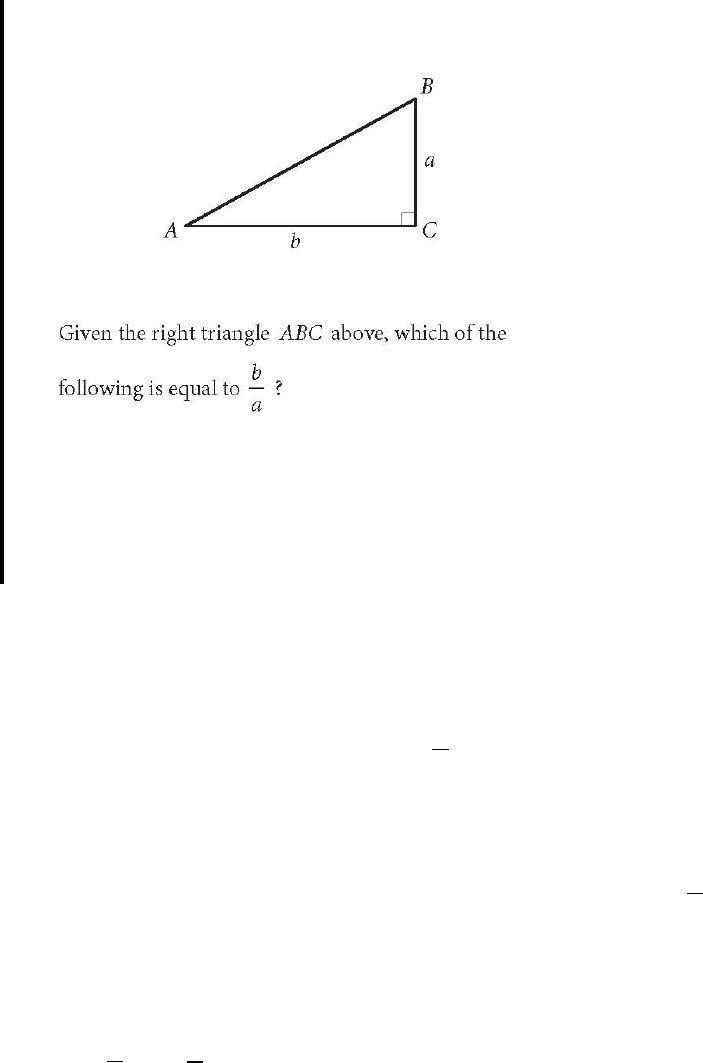
PSAT/NMSQT Practice Test #1 Math Test – Calculator Answer Explanations
implies that
135 – w = 3w – 9. Solving this for w gives w = 36, and so l = 99. The area
of the garden would then be
36 × 99 square feet, which is clearly less than 5,600
square feet.
Question 26
A) sin A
B) sin B
C) tan A
D) tan B
Item Difficulty: Hard
Content: Additional Topic in Math
Correct Answer: D
Choice D is the correct answer. Since the ratio
b
a
involves only the legs of the
right triangle, it follows that, of the given choices, the ratio can be equal to the
tangent of one of the angles. In a right triangle, the tangent of an acute angle is
defined as the ratio of the opposite side to the adjacent side of the angle. Side
b is
opposite to angle
B and side a is adjacent to angle B. Therefore,
tan .
b
B
a
=
Choices A and B cannot be correct; the sine of an acute angle in a right triangle is
defined as the ratio of the opposite side to the hypotenuse, and the ratio shown
involves only the legs of the triangle. Choice C is incorrect. In the triangle
ABC
shown,
tan ,
a
A
b
=
not
b
a
.
Page 88
M2
M2
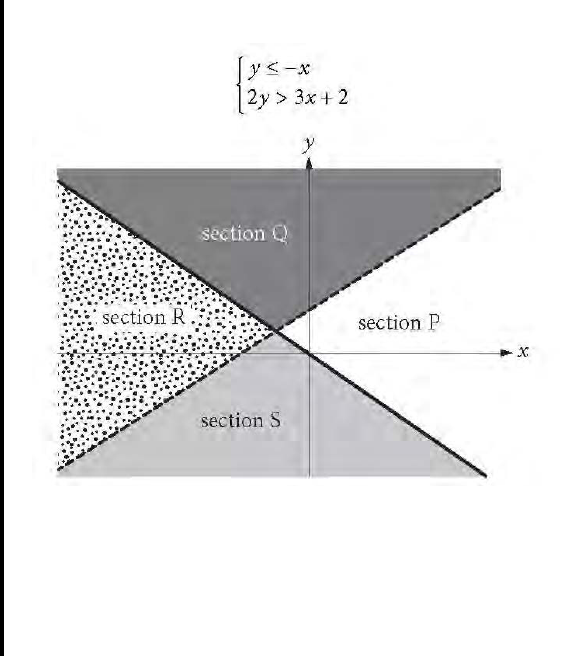
PSAT/NMSQT Practice Test #1 Math Test – Calculator Answer Explanations
Question 27
A system of inequalities and a graph are shown above. Which section or sections of
the graph could represent all of the solutions to the system?
A) Section R
B) Sections Q and S
C) Sections Q and P
D)Sections Q, R, and S
Item Difficulty: Hard
Content: Heart of Algebra
Correct Answer: A
Choice A is the correct answer. The solution set of the inequality
y ≤ –x is the union
of sections R and S of the graph. The solution set of the inequality
2y > 3x + 2 is the
union of sections R and Q of the graph. The solutions of the system consist of the
coordinates of all the points that satisfy both inequalities, and therefore, section R
represents all the solutions to the system since it is common to the solutions of
both inequalities.
Choices B, C, and D are incorrect because they contain ordered pairs that do not
satisfy both of the inequalities.
Page 89
M2
M2
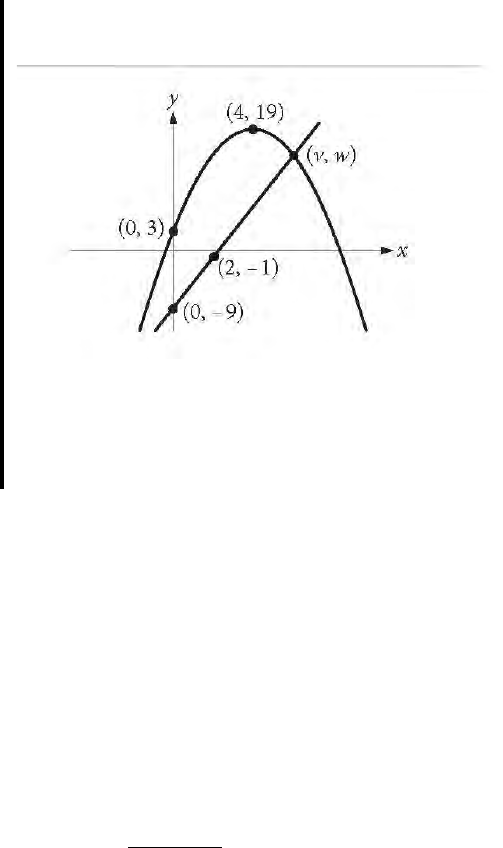
PSAT/NMSQT Practice Test #1 Math Test – Calculator Answer Explanations
Question 28
The xy-plane above shows one of the two points of intersection of the
graphs of a linear function and a quadratic function. The shown point of
intersection has coordinates (v,w). If the vertex of the graph of the
quadratic function is at (4, 19), what is the value of v ?
Item Difficulty: Medium
Content: Passport to Advanced Math
The correct answer is
6.
Since the vertex of the graph of the quadratic function is at
(4, 19), the equation of
the parabola is of the form
y = a(x – 4)2 + 19. It is also given that the parabola
passes through point
(0, 3). This means that
a(3 – 4)
2
+ 19, and so a = –1. So the graph of the parabola is y = –(x – 4)2 + 19.
Since the line passes through the points
(0, –9) and (2, –1), one can calculate the
slope of the line
(
)
1(9)
4
20
---
=
-
that passes through these points and write the
equation of the line in the slope-intercept form as
y = 4x – 9.
The coordinates of the intersection points of the line and the parabola satisfy both
the equation of the parabola and the equation of the line. Therefore, these
coordinates are the solutions to the system of equations below:
y = 4x – 9
y = –(x – 4)
2
+ 19
Substituting
4x – 9 for y into the second equation gives 4x – 9 = –(x – 4)
2
+ 19, which
is equivalent to
x2 – 4x – 12 = 0. After factoring, this equation can be rewritten as
Page 90
M2
M2
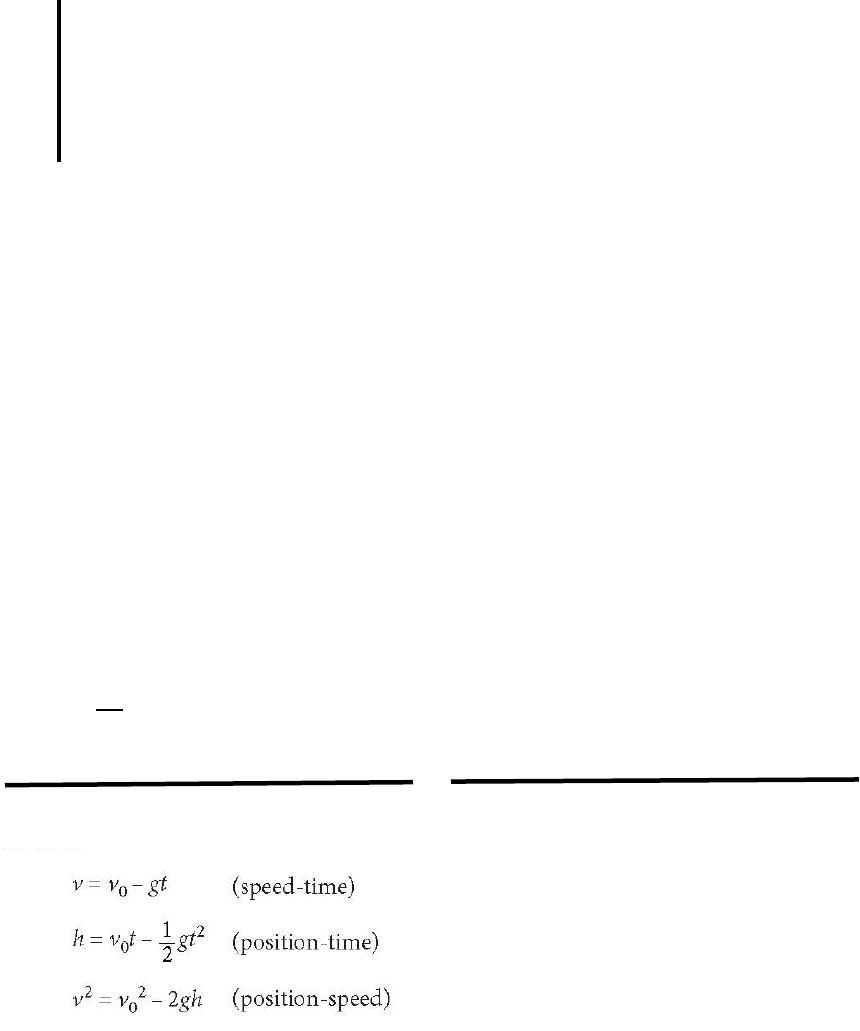
PSAT/NMSQT Practice Test #1 Math Test – Calculator Answer Explanations
(x – 6)(x + 2) = 0, and so x = 6 or x = –2. Since point (v, w) is on the right side of the
y-axis, it follows that v cannot be –2. Therefore, v = 6.
Question 29
In a college archaeology class, 78 students are going to a dig site to find
and study artifacts. The dig site has been divided into 24 sections, and each
section will be studied by a group of either 2 or 4 students. How many of
the sections will be studied by a group of 2 students?
Item Difficulty: Hard
Content: Heart of Algebra
The correct answer is
9.
Let
x be the number of sections that will be studied by 2 students and y be the
number of sections that will be studied by
4 students. Since there are 24 sections
that will be studied by
78 students, it follows that x + y = 24 and 2x + 4y = 78.
Solving this system gives
x = 9 and y = 15. Therefore, 9 of the sections will be
studied by a group of
2 students.
Alternatively, if all
24 sections were studied by a group of 4 students, then the total
number of students required would be
24 × 4 = 96. Since the actual number of
students is
78, the difference 96 – 78 = 18 represents the number of “missing”
students, and each pair of these “missing” students represents one of the sections
that will be studied by
2 students. Hence, the number of sections that will be
studied by
2 students is equal to the number of pairs that 18 students can form,
which is
18
9.
2
=
▼
Questions 30 and 31 refer to the following information.
An arrow is launched upward with an initial speed of 100 meters per second (m/s). The
equations above describe the constant-acceleration motion of the arrow, where v
0
is the
initial speed of the arrow, v is the speed of the arrow as it is moving up in the air, h is the
height of the arrow above the ground, t is the time elapsed since the arrow was projected
upward, and g is the acceleration due to gravity (9.8 m/s
2
).
Page 91
M2
M2
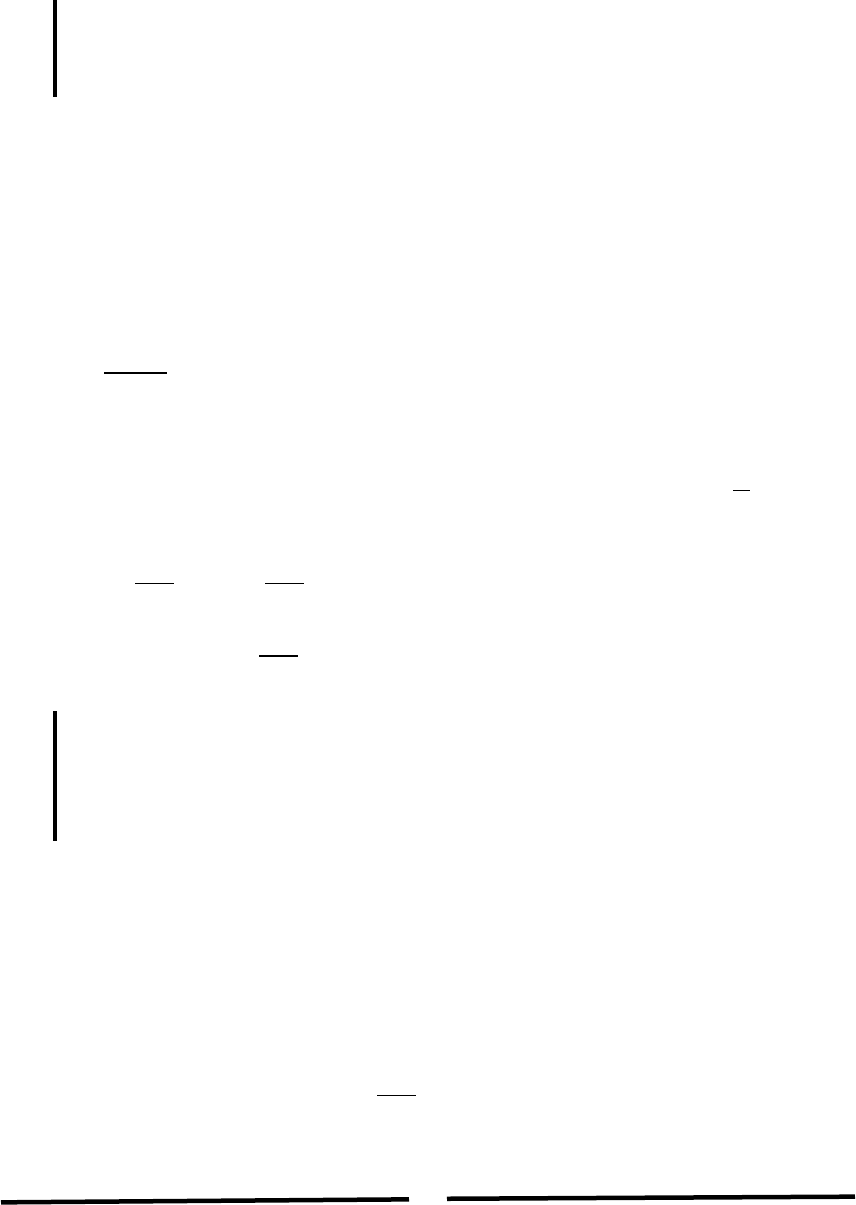
PSAT/NMSQT Practice Test #1 Math Test – Calculator Answer Explanations
Question 30
What is the maximum height from the ground the arrow will rise to the
nearest meter?
Item Difficulty: Hard
Content: Passport to Advanced Math
The correct answer is
510.
As the arrow moves upward, its speed decreases continuously and it becomes
0
when the arrow reaches its maximum height. Using the position-speed equation
and the fact that
0v =
when h is maximum gives 0 = 100
2
− 2gh. Solving for h
gives
2
100
2(9.8)
h =
meters, which to the nearest meter is 510.
Alternatively, the maximum height can be found using the position-time equation.
Substituting
100 for v
0
and 9.8 for g into this equation gives
2
1
100 (9.8) .
2
ht t=-
Completing the square gives the equivalent equation
(
)
(
)
22
100 100
4.9 4.9 .
9.8 9.8
ht=- - +
Therefore, the maximum height from the ground
the arrow will rise is
(
)
2
100
4.9
9.8
meters, which to the nearest meter is 510.
Question 31
How long will it take for the arrow to reach its maximum height to the
nearest tenth of a second?
Item Difficulty: Hard
Content: Passport to Advanced Math
The correct answer is
10.2 seconds (or 51/5 seconds).
As the arrow moves upward, its speed decreases continuously, and it becomes 0
when the arrow reaches its maximum height. Using the speed-time equation and
the fact that
0v =
when h is maximum, we get 0 = 100 – 9.8t.
Solving this equation for t gives
100
10.2041
9.8
t ==
seconds, which to the nearest
tenth of a second is
10.2.
▲
Page 92
M2
M2
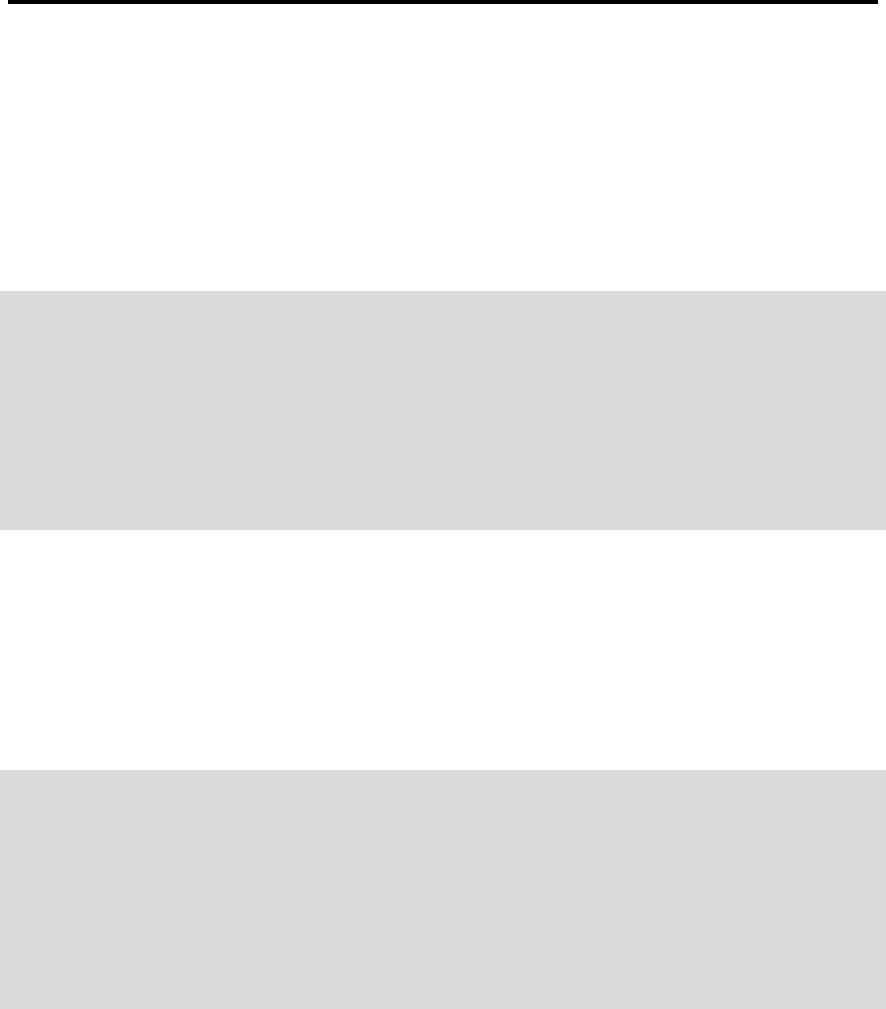
Practice PSAT/NMSQT Form 6
Answer Key
Reading
Q 1 A
Q 2 A
Q 3 B
Q 4 C
Q 5 C
Q 6 B
Q 7 B
Q 8 D
Q 9 B
Writing &
Language
Q 1 C
Q 2 D
Q 3 C
Q 4 D
Q 5 C
Q 6 A
Q 7 B
Q 8 B
Q 9 B
Math Test – No
Calculator
Q 1 A
Q 2 B
Q 3 A
Q 4 D
Q 5 B
Q 6 B
Q 7 A
Q 8 D
Q 9 B
Math Test –
Calculator
Q 1 C
Q 2 A
Q 3 C
Q 4 C
Q 5 C
Q 6 D
Q 7 D
Q 8 D
Q 9 C
Q 10 C
Q 11 B
Q 12 A
Q 13 A
Q 14 D
Q 15 D
Q 16 A
Q 17 D
Q 18 C
Q 19 D
Q 10 D
Q 11 D
Q 12 C
Q 13 B
Q 14 B
Q 15 B
Q 16 D
Q 17 A
Q 18 A
Q 19 D
Q 10 D
Q 11 C
Q 12 A
Q 13 D
Q 14 300
Q 15 2
Q 16 9
Q 17 4
Q 10 B
Q 11 C
Q 12 B
Q 13 B
Q 14 B
Q 15 B
Q 16 C
Q 17 C
Q 18 C
Q 19 A
Q 20 C
Q 21 D
Q 22 A
Q 23 B
Q 24 B
Q 25 D
Q 26 D
Q 27 A
Q 28 A
Q 29 B
Q 20 C
Q 21 C
Q 22 A
Q 23 D
Q 24 A
Q 25 A
Q 26 B
Q 27 C
Q 28 D
Q 29 C
Q 20 C
Q 21 C
Q 22 B
Q 23 D
Q 24 A
Q 25 A
Q 26 D
Q 27 A
Q 28 6
Q 29 9
Q 30 C
Q 31 D
Q 32 C
Q 33 B
Q 34 D
Q 35 C
Q 36 D
Q 37 B
Q 38 D
Q 39 B
Q 30 D
Q 31 D
Q 32 D
Q 33 A
Q 34 C
Q 35 A
Q 36 D
Q 37 D
Q 38 C
Q 39 B
Q 30 510
Q 31 10.2, 51/
Q 40 D
Q 41 B
Q 42 A
Q 43 C
Q 44 C
Q 45 B
Q 46 C
Q 47 A
Q 40 C
Q 41 B
Q 42 B
Q 43 A
Q 44 D
Page 93
26
QUESTION 43.
Choice D is the best answer because it creates a complete and coherent
sentence.
Choices A, B, and C are incorrect because each inserts an unnecessary rela-
tive pronoun or conjunction, resulting in a sentence without a main verb.
QUESTION 44.
Choice D is the best answer because it provides a possessive pronoun that is
consistent with the sentence’s plural subject “students,” thus creating a gram-
matically sound sentence.
Choices A, B, and C are incorrect because each proposes a possessive pro-
noun that is inconsistent with the plural noun “students,” the established
subject of the sentence.
Section 3: Math Test — No Calculator
QUESTION 1.
Choice D is correct. Since k = 3, one can substitute 3 for k in the equa-
tion
x − 1
_
3
= k, which gives
x − 1
_
3
= 3. Multiplying both sides of
x − 1
_
3
= 3
by 3 gives x − 1 = 9 and then adding 1 to both sides of x − 1 = 9 gives x = 10.
Choices A, B, and C are incorrect because the result of subtracting 1 from
the value and dividing by 3 is not the given value of k, which is 3.
QUESTION 2.
Choice A is correct. To ca lculate (7 + 3i) + (−8 + 9i), add the real parts of
each complex number, 7 + (−8) = −1, and then add the imaginary parts,
3i + 9i = 12i. e result is −1 + 12i.
Choices B, C, and D are incorrect and likely result from common errors that
arise when adding complex numbers. For example, choice B is the result of
adding 3i and −9i, and choice C is the result of adding 7 and 8.
QUESTION 3.
Choice C is correct. e total number of messages sent by Armand
is the 5 hours he spent texting multiplied by his rate of texting:
m texts/hour × 5 hours = 5m texts. Similarly, the total number of messages
sent by Tyrone is the 4 hours he spent texting multiplied by his rate of tex-
ting: p texts/hour × 4 hours = 4p texts. e total number of messages sent
by Armand and Tyrone is the sum of the total number of messages sent by
Armand and the total number of messages sent by Tyrone: 5m + 4p.
M3
M3
27
Choice A is incorrect and arises from adding the coecients and multiplying
the variables of 5m and 4p. Choice B is incorrect and is the result of multiply-
ing 5m and 4p. e total number of messages sent by Armand and Tyrone
should be the sum of 5m and 4p, not the product of these terms. Choice D is
incorrect because it multiplies Armand’s number of hours spent texting by
Tyrone’s rate of texting, and vice versa. is mix-up results in an expression
that does not equal the total number of messages sent by Armand and Tyrone.
QUESTION 4.
Choice B is correct. e value 108 in the equation is the value of P in
P = 108 − 23 d when d = 0. When d = 0, Kathy has worked 0 days that week.
In other words, 108 is the number of phones le before Kathy has started
work for the week. erefore, the meaning of the value 108 in the equation
is that Kathy starts each week with 108 phones to x because she has worked
0 days and has 108 phones le to x.
Choice A is incorrect because Kathy will complete the repairs when P = 0.
Since P = 108 − 23d, this will occur when 0 = 108 − 23d or when d =
108
_
23
,
not when d = 108. erefore, the value 108 in the equation does not repre-
sent the number of days it will take Kathy to complete the repairs. Choices C
and D are incorrect because the number 23 in P = 108 − 23P = 108 indicates
that the number of phones le will decrease by 23 for each increase in the
value of d by 1; in other words, that Kathy is repairing phones at a rate of
23 per day, not 108 per hour (choice C) or 108 per day (choice D).
QUESTION 5.
Choice C is correct. Only like terms, with the same variables and exponents,
can be combined to determine the answer as shown here:
(x
2
y − 3y
2
+ 5xy
2
) − (−x
2
y + 3xy
2
− 3y
2
)
= (x
2
y − (−x
2
y)) + (−3y
2
− (−3y
2
)) + (5xy
2
− 3xy
2
)
= 2x
2
y + 0 + 2xy
2
= 2x
2
y + 2xy
2
Choices A, B, and D are incorrect and are the result of common calculation
errors or of incorrectly combining like and unlike terms.
QUESTION 6.
Choice A is correct. In the equation h = 3a + 28.6, if a, the age of the
boy, increases by 1, then h becomes h = 3(a + 1) + 28.6 = 3a + 3 + 28.6 =
(3a + 28.6) + 3. erefore, the model estimates that the boy’s height increases
by 3 inches each year.
Alternatively: e height, h, is a linear function of the age, a, of the boy. e
coecient 3 can be interpreted as the rate of change of the function; in this
M3M3
M3M3

28
case, the rate of change can be described as a change of 3 inches in height for
every additional year in age.
Choices B, C, and D are incorrect and are likely to result from common
errors in calculating the value of h or in calculating the dierence between
the values of h for dierent values of a.
QUESTION 7.
Choice B is correct. Since the right-hand side of the equation is P times the
expression
(
1 +
r
_
1,200
)
N
− 1
(
r
_
1,200
)
(
1 +
r
_
1,200
)
N
, multiplying both sides of the equation by
the reciprocal of this expression results in
(
r
_
1,200
)
(
1 +
r
_
1,200
)
N
(
1 +
r
_
1,200
)
N
− 1
m = P.
Choices A, C, and D are incorrect and are likely the result of conceptual or
computation errors while trying to solve for P.
QUESTION 8.
Choice C is correct. Since
a
_
b
= 2, it follows that
b
_
a
=
1
_
2
. Multiplying both sides
of the equation by
4 gives 4
(
b
_
a
)
=
4b
_
a
= 2.
Choice A is incorrect because if
4b
_
a
= 0, then
a
_
b
would be undened.
Choice B is incorrect because if
4b
_
a
= 1, then
a
_
b
= 4. Choice D is incorrect
because if
4b
_
a
= 4, then
a
_
b
= 1.
QUESTION 9.
Choice B is correct. Adding x and 19 to both sides of 2y − x = −19
gives x = 2y + 19. en, substituting 2y + 19 for x in 3x + 4y = −23 gives
3(2y + 19) + 4y = −23. is last equation is equivalent to 10y + 57 = −23.
Solving 10y + 57 = −23 gives y = −8. Finally, substituting −8 for y in
2y − x = −19 gives 2(−8) − x = −19, or x = 3. erefore, the solution (x, y) to
the given system of equations is (3, −8).
Choices A, C, and D are incorrect because when the given values of x and y
are substituted in 2y − x = −19, the value of the le side of the equation does
not equal −19.
QUESTION 10.
Choice A is correct. Since g is an even function, g(−4) = g(4) = 8.
Alternatively: First nd the value of a, and then nd g(−4). Since g(4) = 8,
substituting 4 for x and 8 for g(x) gives 8 = a(4)
2
+ 24 = 16a + 24. Solving this
M3
M3

29
last equation gives a = −1. us g(x) = −x
2
+ 24, from which it follows that
g(−4) = −(−4)
2
+ 24; g(−4) = −16 + 24; and g(−4) = 8.
Choices B, C, and D are incorrect because g is a function and there can only
be one value of g(−4).
QUESTION 11.
Choice D is correct. To determine the price per pound of beef when it was
equal to the price per pound of chicken, determine the value of x (the num-
ber of weeks aer July 1) when the two prices were equal. e prices were
equal when b = c; that is, when 2.35 + 0.25x = 1.75 + 0.40x. is last equation
is equivalent to 0.60 = 0.15x, and so x =
0.60
_
0.15
= 4. en to determine b, the
price per pound of beef, substitute 4 for x in b = 2.35 + 0.25x, which gives
b = 2.35 + 0.25(4) = 3.35 dollars per pound.
Choice A is incorrect. It results from using the value 1, not 4, for x in
b = 2.35 + 0.25x. Choice B is incorrect. It results from using the value 2,
not 4, for x in b = 2.35 + 0.25x. Choice C is incorrect. It results from using
the value 3, not 4, for x in c = 1.75 + 0.40x.
QUESTION 12.
Choice D is correct. Determine the equation of the line to nd the relation-
ship between the x- and y-coordinates of points on the line. All lines through
the origin are of the form y = mx, so the equation is y =
1
_
7
x. A point lies on
the line if and only if its y-coordinate is
1
_
7
of its x-coordinate. Of the given
choices, only choice D, (14, 2), satises this condition: 2 =
1
_
7
(14).
Choice A is incorrect because the line determined by the origin (0, 0) and (0, 7) is
the vertical line with equation x = 0; that is, the y-axis. e slope of the y-axis is
undened, not
1
_
7
. erefore, the point (0, 7) does not lie on the line that passes
the origin and has slope
1
_
7
. Choices B and C are incorrect because neither of the
ordered pairs has a y-coordinate that is
1
_
7
the value of the x-coordinate.
QUESTION 13.
Choice B is correct. To re write
1
_
x + 2
+
1
_
x + 3
1
, multiply by
(x + 2)(x + 3)
(x + 2)(x + 3)
.
is results in the expression
(x + 2)(x + 3)
(x + 3) + (x + 2)
, which is equivalent to the
expression in choice B.
Choices A, C, and D are incorrect and could be the result of common alge-
braic errors that arise while manipulating a complex fraction.
QUESTION 14.
Choice A is correct. One approach is to express
8
x
_
2
y
so that the numerator
and denominator are expressed with the same base. Since 2 and 8 are both
M3
M3
30
powers of 2, substituting 2
3
for 8 in the numerator of
8
x
_
2
y
gives
(2
3
)
x
_
2
y
, which
can be rewritten as
2
3x
_
2
y
. Since the numerator and denominator of
2
3x
_
2
y
have
a common base, this expression can be rewritten as 2
3x−y
. It is given that
3x − y = 12, so one can substitute 12 for the exponent, 3x − y, giving that the
expression
8
x
_
2
y
is equal to 2
12
.
Choices B and C are incorrect because they are not equal to 2
12
. Choice D is
incorrect because the value
of
8
x
_
2
y
can be determined.
QUESTION 15.
Choice D is correct. One can nd the possible values of a and b in
(ax + 2)(bx + 7) by using the given equation a + b = 8 and nd-
ing another equation that relates the variables a and b. Since
(ax + 2)(bx + 7) = 15x
2
+ cx + 14, one can expand the le side of the equation
to obtain abx
2
+ 7ax + 2bx + 14 = 15x
2
+ cx + 14. Since ab is the coecient of
x
2
on the le side of the equation and 15 is the coecient of x
2
on the right
side of the equation, it must be true that ab = 15. Since a + b = 8, it follows
that b = 8 − a. us, ab = 15 can be rewritten as a(8 − a) = 15, which in turn
can be rewritten as a
2
− 8a + 15 = 0. Factoring gives (a − 3)(a − 5) = 0. us,
either a = 3 and b = 5, or a = 5 and b = 3. If a = 3 and b = 5, then (ax + 2)
(bx + 7) = (3x + 2)(5x + 7) = 15x
2
+ 31x + 14. us, one of the possible val-
ues of c is 31. If a = 5 and b = 3, then (ax + 2)(bx + 7) = (5x + 2)(3x + 7) =
15x
2
+ 41x + 14. us, another possible value for c is 41. erefore, the two
possible values for c are 31 and 41.
Choice A is incorrect; the numbers 3 and 5 are possible values for a and
b, but not possible values for c. Choice B is incorrect; if a = 5 and b = 3,
then 6 and 35 are the coecients of x when the expression (5x + 2)(3x + 7)
is expanded as 15x
2
+ 35x + 6x + 14. However, when the coecients of x
are 6 and 35, the value of c is 41 and not 6 and 35. Choice C is incorrect; if
a = 3 and b = 5, then 10 and 21 are the coecients of x when the expression
(3x + 2)(5x + 7) is expanded as 15x
2
+ 21x + 10x + 14. However, when the
coecients of x are 10 and 21, the value of c is 31 and not 10 and 21.
QUESTION 16.
The correct answer is 2. To solve for t, factor the le side of t
2
− 4 = 0, giv-
ing (t − 2)(t + 2) = 0. erefore, either t − 2 = 0 or t + 2 = 0. If t − 2 = 0, then
t = 2, and if t + 2 = 0, then t = −2. Since it is given that t > 0, the value of t
must be 2.
Another way to solve for t is to add 4 to both sides of t
2
− 4 = 0, giving t
2
= 4.
en, taking the square root of the le and the right side of the equation
gives t = ±
√
_
4 = ±2. Since it is given that t > 0, the value of t must be 2.
M3
M3
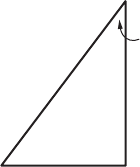
31
QUESTION 17.
The correct answer is 1600. It is given that ∠AEB and ∠CDB have the
same measure. Since ∠ABE and ∠CBD are vertical angles, they have the
same measure. erefore, triangle EAB is similar to triangle DCB because
the triangles have two pairs of congruent corresponding angles (angle-
angle criterion for similarity of triangles). Since the triangles are similar, the
corresponding sides are in the same proportion; thus
CD
_
x
=
BD
_
EB
. Substituting
the given values of 800 for CD, 700 for BD, and 1400 for EB in
CD
_
x
=
BD
_
EB
gives
800
_
x
=
700
_
1400
. erefore, x =
(800)(1400)
_
700
= 1600.
QUESTION 18.
The correct answer is 7. Subtracting the le and right sides of x + y = −9 from
the corresponding sides of x + 2y = −25 gives (x + 2y) − (x + y) = −25 − (−9),
which is equivalent to y = −16. Substituting −16 for y in x + y = −9 gives
x + (−16) = −9, which is equivalent to x = −9 − (−16) = 7.
QUESTION 19.
The correct answer is
4
_
5
or 0.8. By the complementary angle relationship
for sine and cosine, sin(x°) = cos(90° − x°). erefore, cos(90° − x°) =
4
_
5
.
Either the fraction
4
_
5
or its decimal equivalent, 0.8, may be gridded as the
correct answer.
Alternatively, one can construct a right triangle that has an angle of measure
x° such that sin(x°) =
4
_
5
, as shown in the gure below, where sin(x°) is equal
to the ratio of the opposite side to the hypotenuse, or
4
_
5
.
5
4
90°
90 –
x
x
Since two of the angles of the triangle are of measure x° and 90°, the third
angle must have the measure 180° − 90° − x° = 90° − x°. From the gure,
cos(90° − x°), which is equal to the ratio of the adjacent side to the hypot-
enuse, is also
4
_
5
.
QUESTION 20.
The correct answer is 100. Since a = 5
√
_
2 , one can substitute 5
√
_
2 for a in
2a =
√
_
2 x, giving 10
√
_
2 =
√
_
2 x. Squaring each side of 10
√
_
2 =
√
_
2 x gives
(10
√
_
2 )
2
= (
√
_
2 x)
2
, which simplies to (10)
2
(
√
_
2 )
2
= (
√
_
2 x)
2
, or 200 = 2x. is gives
x = 100. Checking x = 100 in the original equation gives 2(5
√
_
2 ) =
√
_
(2)(100) ,
which is true since 2(5
√
_
2 ) = 10
√
_
2 and
√
_
(2)(100) = (
√
_
2 )(
√
_
100 ) = 10
√
_
2 .
M3
M3
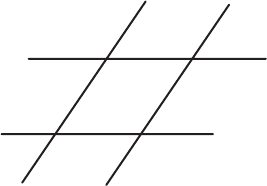
32
Section 4: Math Test — Calculator
QUESTION 1.
Choice B is correct. On the graph, a line segment with a positive slope rep-
resents an interval over which the target heart rate is strictly increasing as
time passes. A horizontal line segment represents an interval over which
there is no change in the target heart rate as time passes, and a line seg-
ment with a negative slope represents an interval over which the target heart
rate is strictly decreasing as time passes. Over the interval between 40 and
60 minutes, the graph consists of a line segment with a positive slope fol-
lowed by a line segment with a negative slope, with no horizontal line seg-
ment in between, indicating that the target heart rate is strictly increasing
then strictly decreasing.
Choice A is incorrect because the graph over the interval between 0 and
30 minutes contains a horizontal line segment, indicating a period in
which there was no change in the target heart rate. Choice C is incorrect
because the graph over the interval between 50 and 65 minutes consists of
a line segment with a negative slope followed by a line segment with a pos-
itive slope, indicating that the target heart rate is strictly decreasing then
strictly increasing. Choice D is incorrect because the graph over the interval
between 70 and 90 minutes contains horizontal line segments and no seg-
ment with a negative slope.
QUESTION 2.
Choice C is correct. Substituting 6 for x and 24 for y in y = kx gives 24 = (k)(6),
which gives k = 4. Hence, y = 4x. erefore, when x = 5, the value of y is
(4)(5) = 20. None of the other choices for y is correct because y is a function of
x, and so there is only one y-value for a given x-value.
Choices A, B, and D are incorrect. Choice A is the result of using 6 for y
and 5 for x when solving for k. Choice B results from using a value of 3 for k
when solving for y. Choice D results from using y = k + x instead of y = kx.
QUESTION 3.
Choice D is correct. Consider the measures of ∠3 and ∠4 in the gure below.
m
1
2
4
3
s
t
ℓ
M4
M4
33
e measure of ∠3 is equal to the measure of ∠1 because they are corre-
sponding angles for the parallel lines and m intersected by the transversal
line t. Similarly, the measure of ∠3 is equal to the measure of ∠4 because
they are corresponding angles for the parallel lines s and t intersected by
the transversal line m. Since the measure of ∠1 is 35°, the measures of
∠3 and ∠4 are also 35°. Since ∠4 and ∠2 are supplementary, the sum of
the measures of these two angles is 180°. erefore, the measure of ∠2 is
180° − 35° = 145°.
Choice A is incorrect because 35° is the measure of ∠1, and ∠1 is not con-
gruent to ∠ 2. Choice B is incorrect because it is the measure of the com-
plementary angle of ∠1, and ∠1 and ∠2 are not complementary angles.
Choice C is incorrect because it is double the measure of ∠1.
QUESTION 4.
Choice C is correct. e description “16 + 4x is 10 more than 14” can be
written as the equation 16 + 4x = 10 + 14, which is equivalent to 16 + 4x = 24.
Subtracting 16 from each side of 16 + 4x = 24 gives 4x = 8. Since 8x is 2 times
4x, multiplying both sides of 4x = 8 by 2 gives 8x = 16. erefore, the value
of 8x is 16.
Choice A is incorrect because it is the value of x, not 8x. Choices B and D
are incorrect; those choices may be a result of errors in rewriting 16 + 4x =
10 + 14. For example, choice D could be the result of subtracting 16 from the
le side of the equation and adding 16 to the right side of 16 + 4x = 10 + 14,
giving 4x = 40 and 8x = 80.
QUESTION 5.
Choice D is correct. A graph with a strong negative association between
d and t would have the points on the graph closely aligned with a line that
has a negative slope. e more closely the points on a graph are aligned with
a line, the stronger the association between d and t, and a negative slope
indicates a negative association. Of the four graphs, the points on graph
D are most closely aligned with a line with a negative slope. erefore, the
graph in choice D has the strongest negative association between d and t.
Choice A is incorrect because the points are more scattered than the
points in choice D, indicating a weak negative association between d and t.
Choice B is incorrect because the points are aligned to either a curve or pos-
sibly a line with a small positive slope. Choice C is incorrect because the
points are aligned to a line with a positive slope, indicating a positive asso-
ciation between d and t.
M4
M4
34
QUESTION 6.
Choice D is correct. Since there are 10 grams in 1 decagram, there are
2 × 10 = 20 grams in 2 decagrams. Since there are 1,000 milligrams in
1 gram, there are 20 × 1,000 = 20,000 milligrams in 20 grams. erefore,
20,000 1-milligram doses of the medicine can be stored in a 2-decagram
container.
Choice A is incorrect; 0.002 is the number of grams in 2 milligrams. Choice B is
incorrect; it could result from multiplying by 1,000 and dividing by 10 instead
of multiplying by both 1,000 and 10 when converting from decagrams to mil-
ligrams. Choice C is incorrect; 2,000 is the number of milligrams in 2 grams, not
the number of milligrams in 2 decagrams.
QUESTION 7.
Choice C is correct. Let x represent the number of installations that each
unit on the y-axis represents. en 9x, 5x, 6x, 4x, and 3.5x are the num-
ber of rooops with solar panel installations in cities A, B, C, D, and E,
respectively. Since the total number of rooops is 27,500, it follows that
9x + 5x + 6x + 4x + 3.5x = 27,500, which simplies to 27.5x = 27,500. us,
x = 1,000. erefore, an appropriate label for the y-axis is “Number of instal-
lations (in thousands).”
Choices A, B, and D are incorrect and may result from errors when setting
up and calculating the units for the y-axis.
QUESTION 8.
Choice D is correct. If the value of |n − 1| + 1 is equal to 0, then |n − 1| + 1 = 0.
Subtracting 1 from both sides of this equation gives |n − 1| = −1. e expres-
sion |n − 1| on the le side of the equation is the absolute value of n − 1,
and the absolute value can never be a negative number. us |n − 1| = −1
has no solution. erefore, there are no values for n for which the value of
|n − 1| + 1 is equal to 0.
Choice A is incorrect because |0 − 1| + 1 = 1 + 1 = 2, not 0. Choice B is incor-
rect because |1 − 1| + 1 = 0 + 1 = 1, not 0. Choice C is incorrect because
|2 − 1| + 1 = 1 + 1 = 2, not 0.
QUESTION 9.
Choice A is correct. Subtracting 1,052 from both sides of the equa-
tion a = 1,052 + 1.08t gives a − 1,052 = 1.08t. en dividing both sides of
a − 1,052 = 1.08t by 1.08 gives t =
a − 1,052
_
1.08
.
Choices B, C, and D are incorrect and could arise from errors in rewriting
a = 1,052 + 1.08t. For example, choice B could result if 1,052 is added to the
M4
M4
35
le side of a = 1,052 + 1.08t and subtracted from the right side, and then
both sides are divided by 1.08.
QUESTION 10.
Choice B is correct. Substituting 1,000 for a in the equation a = 1,052 + 1.08t
gives 1,000 = 1,052 + 1.08t, and thus t =
−52
_
1.08
≈ − 48.15. Of the choices given,
−48°F is closest to −48.15°F. Since the equation a = 1,052 + 1.08t is linear,
it follows that of the choices given, −48°F is the air temperature when the
speed of a sound wave is closest to 1,000 feet per second.
Choices A, C, and D are incorrect, and might arise from errors in
calculating
−52
_
1.08
or in rounding the result to the nearest integer. For exam-
ple, choice C could be the result of rounding −48.15 to −49 instead of −48.
QUESTION 11.
Choice A is correct. Subtracting 3x and adding 3 to both sides of
3x − 5 ≥ 4x − 3 gives −2 ≥ x. erefore, x is a solution to 3x − 5 ≥ 4x − 3 if and
only if x is less than or equal to −2 and x is NOT a solution to 3x − 5 ≥ 4x − 3 if
and only if x is greater than −2. Of the choices given, only −1 is greater than
−2 and, therefore, cannot be a value of x.
Choices B, C, and D are incorrect because each is a value of x that is less than
or equal to −2 and, therefore, could be a solution to the inequality.
QUESTION 12.
Choice C is correct. e average number of seeds per apple is the total
number of seeds in the 12 apples divided by the number of apples, which
is 12. On the graph, the horizontal axis is the number of seeds per apple
and the height of each bar is the number of apples with the correspond-
ing number of seeds. e rst bar on the le indicates that 2 apples have
3 seeds each, the second bar indicates that 4 apples have 5 seeds each,
the third bar indicates that 1 apple has 6 seeds, the fourth bar indicates
that 2 apples have 7 seeds each, and the h bar indicates that 3 apples
have 9 seeds each. us, the total number of seeds for the 12 apples
is (2 × 3) + (4 × 5) + (1 × 6) + (2 × 7) + (3 × 9) = 73, and the average
number of seeds per apple is
73
_
12
= 6.08. Of the choices given, 6 is closest
to 6.08.
Choice A is incorrect; it is the number of apples represented by the tallest
bar but is not the average number of seeds for the 12 apples. Choice B is
incorrect; it is the number of seeds per apple corresponding to the tallest
bar, but is not the average number of seeds for the 12 apples. Choice D is
incorrect; a student might choose this by correctly calculating the average
number of seeds, 6.08, but incorrectly rounding up to 7.
M4
M4
36
QUESTION 13.
Choice C is correct. From the table, there was a total of 310 survey respondents,
and 19% of all survey respondents is equivalent to
19
_
100
× 310 = 58.9 respon-
dents. Of the choices given, 59, the number of males taking geometry, is clos-
est to 58.9 respondents.
Choices A, B, and D are incorrect because the number of males taking
geometry is closer to 58.9 than the number of respondents in each of these
categories.
QUESTION 14.
Choice C is correct. e range of the 21 sh is 24 − 8 = 16 inches, and
the range of the 20 sh aer the 24-inch measurement is removed is
16 − 8 = 8 inches. e change in range, 8 inches, is much greater than the
change in the mean or median.
Choice A is incorrect. Let m be the mean of the lengths, in inches, of the
21 sh. en the sum of the lengths, in inches, of the 21 sh is 21m. Aer
the24-inch measurement is removed, the sum of the lengths, in inches, of
the remaining 20 sh is 21m − 24, and the mean length, in inches, of these
20 sh is
21m − 24
_
20
, which is a change of
24 − m
_
20
inches. Since m must be
between the smallest and largest measurements of the 21 sh, it follows that
8 < m < 24, from which it can be seen that the change in the mean, in inches,
is between
24 − 24
_
20
= 0 and
24 − 8
_
20
=
4
_
5
, and so must be less than the change
in the range, 8 inches. Choice B is incorrect because the median length
of the 21 sh is the length of the 11th sh, 12 inches. Aer removing the
24-inch measurement, the median of the remaining 20 lengths is the average
of the 10th and 11th sh, which would be unchanged at 12 inches. Choice
D is incorrect because the changes in the mean, median, and range of the
measurements are dierent.
QUESTION 15.
Choice A is correct. e total cost C of renting a boat is the sum of the initial
cost to rent the boat plus the product of the cost per hour and the num-
ber of hours, h, that the boat is rented. e C-intercept is the point on the
C-axis where h, the number of hours the boat is rented, is 0. erefore, the
C-intercept is the initial cost of renting the boat.
Choice B is incorrect because the graph represents the cost of renting only
one boat. Choice C is incorrect because the total number of hours of rental is
represented by h-values, each of which corresponds to the rst coordinate of
a point on the graph. Choice D is incorrect because the increase in cost for
each additional hour is given by the slope of the line, not by the C-intercept.
M4
M4
37
QUESTION 16.
Choice C is correct. e relationship between h and C is represented by any
equation of the given line. e C-intercept of the line is 5. Since the points
(0, 5) and (1, 8) lie on the line, the slope of the line is
8 − 5
_
1 − 0
=
3
_
1
= 3. erefore,
the relationship between h and C can be represented by C = 3h + 5, the
slope-intercept equation of the line.
Choices A and D are incorrect because each uses the wrong values for both
the slope and intercept. Choice B is incorrect; this choice would result from
computing the slope by counting the number of grid lines instead of using
the values represented by the axes.
QUESTION 17.
Choice B is correct. e minimum value of the function corresponds to the
y-coordinate of the point on the graph that is the lowest along the vertical
or y-axis. Since the grid lines are spaced 1 unit apart on each axis, the lowest
point along the y-axis has coordinates (−3, −2). erefore, the value of x at
the minimum of f(x) is −3.
Choice A is incorrect;
−5 is the smallest value for an x-coordinate of a point
on the graph of f, not the lowest point on the graph of f. Choice C is incor-
rect; it is the minimum value of f, not the value of x that corresponds to the
minimum of f. Choice D is incorrect; it is the value of x at the maximum
value of f, not at the minimum value of f.
QUESTION 18.
Choice A is correct. Since (0, 0) is a solution to the system of inequalities,
substituting 0 for x and 0 for y in the given system must result in two true
inequalities. Aer this substitution, y < −x + a becomes 0 < a, and y > x + b
becomes 0 > b. Hence, a is positive and b is negative. erefore, a > b.
Choice B is incorrect because b > a cannot be true if b is negative and a
is positive. Choice C is incorrect because it is possible to nd an example
where (0, 0) is a solution to the system, but |a| < |b|; for example, if a = 6 and
b = −7. Choice D is incorrect because the equation a = −b could be true, but
doesn’t have to be true; for example, if a = 1 and b = −2.
QUESTION 19.
Choice B is correct. To de term ine t he numb er of s al ads s old, w rite a nd s olve
a system of two equations. Let x equal the number of salads sold and let y
equal the number of drinks sold. Since the number of salads plus the num-
ber of drinks sold equals 209, the equation x + y = 209 must hold. Since each
M4
M4
38
salad cost $6.50, each soda cost $2.00, and the total revenue was $836.50, the
equation 6.50x + 2.00y = 836.50 must also hold. e equation x + y = 209 is
equivalent to 2x + 2y = 418, and subtracting each side of 2x + 2y = 418 from
the respective side of 6.50x + 2.00y = 836.50 gives 4.5x = 418.50. erefore,
the number of salads sold, x, was x =
418.50
_
4.50
= 93.
Choices A, C, and D are incorrect and could result from errors in writing the
equations and solving the system of equations. For example, choice C could
have been obtained by dividing the total revenue, $836.50, by the total price
of a salad and a soda, $8.50, and then rounding up.
QUESTION 20.
Choice D is correct. Let x be the original price of the computer, in dollars.
e discounted price is 20 percent o the original price, so x − 0.2x = 0.8x is
the discounted price, in dollars. e tax is 8 percent of the discounted price,
so 0.08(0.8x) is the tax on the purchase, in dollars. e price p, in dollars,
that Alma paid the cashiers is the sum of the discounted price and the tax:
p = 0.8x + (0.08)(0.8x) which can be rewritten as p = 1.08(0.8x). erefore,
the original price, x, of the computer, in dollars, can be written as
p
_
(0.8)(1.08)
in terms of p.
Choices A, B, and C are incorrect; each choice either switches the roles
of the original price and the amount Alma paid, or incorrectly com-
bines the results of the discount and the tax as 0.8 + 0.08 = 0.88 instead of
as (0.8)(1.08).
QUESTION 21.
Choice C is correct. e probability that a person from Group Y who recalled
at least 1 dream was chosen from the group of all people who recalled at
least 1 dream is equal to the number of people in Group Y who recalled at
least 1 dream divided by the total number of people in the two groups who
recalled at least 1 dream. e number of people in Group Y who recalled
at least 1 dream is the sum of the 11 people in Group Y who recalled 1 to
4 dreams and the 68 people in Group Y who recalled 5 or more dreams:
11 + 68 = 79. e total number of people who recalled at least 1 dream is
the sum of the 79 people in Group Y who recalled at least 1 dream, the 28
people in Group X who recalled 1 to 4 dreams, and the 57 people in Group
X who recalled 5 or more dreams: 79 + 28 + 57 = 164. erefore, the prob-
ability is
79
_
164
.
Choice A is incorrect; it is the number of people in Group Y who recalled
5or more dreams divided by the total number of people in Group Y. Choice
B is incorrect; it uses the total number of people in Group Y as the denomi-
nator of the probability. Choice D is incorrect; it is the total number of peo-
ple in the two groups who recalled at least 1 dream divided by the total num-
ber of people in the two groups.
M4
M4
39
QUESTION 22.
Choice B is correct. e average rate of change in the annual budget for
agriculture/natural resources from 2008 to 2010 is the total change from to
2008 to 2010 divided by the number of years, which is 2. e total change
in the annual budget for agriculture/natural resources from 2008 to 2010 is
488,106 − 358,708 = 129,398, in thousands of dollars, so the average change
in the annual budget for agriculture/natural resources from 2008 to 2010
is
$129,398,000
__
2
= $64,699,000 per year. Of the options given, this average
rate of change is closest to $65,000,000 per year.
Choices A and C are incorrect; they could result from errors in setting up or
calculating the average rate of change. Choice D is incorrect; $130,000,000 is
the approximate total change from 2008 to 2010, not the average change from
2008 to 2010.
QUESTION 23.
Choice B is correct. The human resources budget in 2007 was
4,051,050 thousand dollars, and the human resources budget in 2010
was 5,921,379 thousand dollars. erefore, the ratio of the 2007 bud-
get to the 2010 budget is slightly greater than
4
_
6
=
2
_
3
. Similar estimates for
agriculture/natural resources give a ratio of the 2007 budget to the 2010
budget of slightly greater than
3
_
4
; for education, a ratio of slightly greater
than
2
_
3
; for highways and transportation, a ratio of slightly less than
5
_
6
; and
for public safety, a ratio of slightly greater than
5
_
9
. erefore, of the given
choices, education’s ratio of the 2007 budget to the 2010 budget is closest to
that of human resources.
Choices A, C, and D are incorrect because the 2007 budget to 2010 budget
ratio for each of these programs in these choices is further from the corre-
sponding ratio for human resources than the ratio for education.
QUESTION 24.
Choice A is correct. e equation of a circle can be written as (x − h)
2
+
(y − k)
2
= r
2
where (h, k) are the coordinates of the center of the circle and
r is the radius of the circle. Since the coordinates of the center of the circle
are (0, 4), the equation is x
2
+ (y − 4)
2
= r
2
, where r is the radius. e radius
of the circle is the distance from the center, (0, 4), to the given endpoint of a
radius,
(
4
_
3
, 5
)
. By the distance formula, r
2
=
(
4
_
3
− 0
)
2
+ (5 − 4)
2
=
25
_
9
. erefore,
an equation of the given circle is x
2
+ (y − 4)
2
=
25
_
9
.
Choice B is incorrect; it results from the incorrect equation (x + h)
2
+
(y + k)
2
= r
2
. Choice C is incorrect; it results from using r instead of r
2
in the
equation for the circle. Choice D is incorrect; it results from using the incor-
rect equation (x + h)
2
+ (y + k)
2
=
1
_
r
.
M4
M4
40
QUESTION 25.
Choice D is correct. When the ball hits the ground, its height is 0 meters.
Substituting 0 for h in h = −4.9t
2
+ 25t gives 0 = −4.9t
2
+ 25t, which can
be rewritten as 0 = t(−4.9t + 25). us, the possible values of t are t = 0
and t =
25
_
4.9
≈ 5.1. e time t = 0 seconds corresponds to the time the ball
is launched from the ground, and the time t ≈ 5.1 seconds corresponds to
the time aer launch that the ball hits the ground. Of the given choices,
5.0 seconds is closest to 5.1 seconds, so the ball returns to the ground
approximately 5.0 seconds aer it is launched.
Choice A, B, and C are incorrect and could arise from conceptual or compu-
tation errors while solving 0 = −4.9t
2
+ 25t for t.
QUESTION 26.
Choice B is correct. Let x represent the number of pears produced by the
Type B trees. en the Type A trees produce 20 percent more pears than x,
which is x + 0.20x = 1.20x pears. Since Type A trees produce 144 pears, the
equation 1.20x = 144 holds. us x =
144
_
1.20
= 120. erefore, the Type B trees
produced 120 pears.
Choice A is incorrect because while 144 is reduced by approximately 20 per-
cent, increasing 115 by 20 percent gives 138, not 144. Choice C is incorrect;
it results from subtracting 20 from the number of pears produced by the
Type A trees. Choice D is incorrect; it results from adding 20 percent of the
number of pears produced by Type A trees to the number of pears produced
by Type A trees.
QUESTION 27.
Choice C is correct. e area of the eld is 100 square meters. Each 1-meter-
by-1-meter square has an area of 1 square meter. us, on average, the earth-
worm counts to a depth of 5 centimeters for each of the regions investigated
by the students should be about
1
_
100
of the total number of earthworms to
a depth of 5 centimeters in the entire eld. Since the counts for the smaller
regions are from 107 to 176, the estimate for the entire eld should be
between 10,700 and 17,600. erefore, of the given choices, 15,000 is a rea-
sonable estimate for the number of earthworms to a depth of 5 centimeters
in the entire eld.
Choice A is incorrect; 150 is the approximate number of earthworms
in 1 square meter. Choice B is incorrect; it results from using 10 square
meters as the area of the eld. Choice D is incorrect; it results from using
1,000 square meters as the area of the eld.
M4
M4
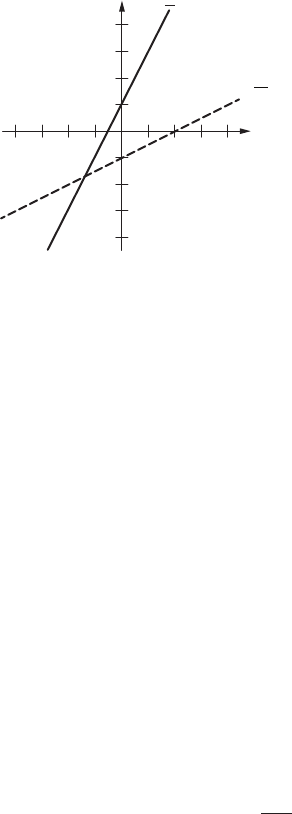
41
QUESTION 28.
Choice C is correct. To d ete rmi ne w hi ch q uad rant d oe s n ot c ont ain any so lu -
tions to the system of inequalities, graph the inequalities. Graph the inequal-
ity y ≥ 2x + 1 by drawing a line through the y-intercept (0, 1) and the point
(1, 3), and graph the inequality y >
1
_
2
x − 1 by drawing a dashed line through
the y-intercept (0, −1) and the point (2, 0), as shown in the gure below.
x
y
II
I
IV
III
y 2x + 1
>
y x –
1
>
2
1
e solution to the system of inequalities is the intersection of the shaded regions
above the graphs of both lines. It can be seen that the solutions only include
points in quadrants I, II, and III and do not include any points in quadrant IV.
Choices A and B are incorrect because quadrants II and III contain solu-
tions to the system of inequalities, as shown in the gure above. Choice D is
incorrect because there are no solutions in quadrant IV.
QUESTION 29.
Choice D is correct. If the polynomial p(x) is divided by x − 3, the result
can be written as
p(x)
_
x − 3
= q(x) +
r
_
x − 3
, where q(x) is a polynomial and r
is the remainder. Since x − 3 is a degree 1 polynomial, the remainder
is a real number. Hence, p(x) can be written as p(x) = (x − 3)q(x) + r,
where r is a real number. It is given that p(3) = −2 so it must be true that
−2 = p(3) = (3 − 3)q(3) + r = (0)q(3) + r = r. erefore, the remainder when
p(x) is divided by x − 3 is − 2.
Choice A is incorrect because p(3) = −2 does not imply that p(5) = 0.
Choices B and C are incorrect because the remainder −2 or its negative, 2,
need not be a root of p(x).
QUESTION 30.
Choice D is correct. Any quadratic function q can be written in the form
q(x) = a(x − h)
2
+ k, where a, h, and k are constants and (h, k) is the vertex of
the parabola when q is graphed in the coordinate plane. (Depending on the
M4
M4
42
sign of a, the constant k must be the minimum or maximum value of q, and
h is the value of x for which a(x − h)
2
= 0 and q(x) has value k.) is form
can be reached by completing the square in the expression that denes q.
e given equation is y = x
2
− 2x − 15, and since the coecient of x is −2,
the equation can be written in terms of (x − 1)
2
= x
2
− 2x + 1 as follows:
y = x
2
− 2x − 15 = (x
2
− 2x + 1) − 16 = (x − 1)
2
−
16. From this form of the
equation, the coecients of the vertex can be read as (1, −16)
Choices A and C are incorrect because the coordinates of the vertex A do
not appear as constants in these equations. Choice B is incorrect because it is
not equivalent to the given equation.
QUESTION 31.
The correct answer is any number between 4 and 6, inclusive. Since Wyatt
can husk at least 12 dozen ears of corn per hour, it will take him no more
than
72
_
12
! 6 hours to husk 72 dozen ears of corn. On the other hand, since
Wyatt can husk at most 18 dozen ears of corn per hour, it will take him
at least
72
_
18
! 4 hours to husk 72 dozen ears of corn. erefore, the possi-
ble times it could take Wyatt to husk 72 dozen ears of corn are 4 hours to
6 hours, inclusive. Any number between 4 and 6, inclusive, can be gridded as
the correct answer.
QUESTION 32.
The correct answer is 107. Since the weight of the empty truck and its driver
is 4500 pounds and each box weighs 14 pounds, the weight, in pounds, of
the delivery truck, its driver, and x boxes is 4500 + 14x. is weight is below
the bridge’s posted weight limit of 6000 pounds if 4500 + 14x < 6000. at
inequality is equivalent to 14x ≤ 1500 or x <
1500
_
14
= 107
1
_
7
. Since the number
of packages must be an integer, the maximum possible value for x that will
keep the combined weight of the truck, its driver, and the x identical boxes
below the bridge’s posted weight limit is 107.
QUESTION 33.
The correct answer is
5
_
8
or .625. Based on the line graph, the number of
portable media players sold in 2008 was 100 million, and the number of
portable media players sold in 2011 was 160 million. erefore, the number
of portable media players sold in 2008 is
100 million
_
160 million
of the portable media
players sold in 2011. is fraction reduces to
5
_
8
. Either
5
_
8
or its decimal
equivalent, .625, may be gridded as the correct answer.
QUESTION 34.
The correct answer is 96. Since each day has a total of 24 hours of time
slots available for the station to sell, there is a total of 48 hours of time slots
M4
M4

43
available to sell on Tuesday and Wednesday. Each time slot is a 30-minute
interval, which is equal to a
1
_
2
-hour interval. erefore, there are a total
of
48 hours
__
1
_
2
hours/time slot
= 96 time slots of 30 minutes for the station to sell on
Tues day and We dnes day.
QUESTION 35.
The correct answer is 6. e volume of a cylinder is πr
2
h, where r is the
radius of the base of the cylinder and h is the height of the cylinder. Since
the storage silo is a cylinder with volume 72π cubic yards and height 8 yards,
it is true that 72π = πr
2
(8), where r is the radius of the base of the cylinder,
in yards. Dividing both sides of 72π = πr
2
(8) by 8π gives r
2
= 9, and so the
radius of base of the cylinder is 3 yards. erefore, the diameter of the base
of the cylinder is 6 yards.
QUESTION 36.
The correct answer is 3. e function h(x) is undened when the denomi-
nator of
1
__
(x − 5)
2
+ 4(x − 5) + 4
is equal to zero. e expression (x − 5)
2
+
4(x − 5) + 4 is a perfect square: (x − 5)
2
+ 4(x − 5) + 4 = ((x − 5) + 2)
2
, which
can be rewritten as (x − 3)
2
. e expression (x − 3)
2
is equal to zero if and
only if x = 3. erefore, the value of x for which h(x) is undened is 3.
QUESTION 37.
The correct answer is 1.02. e initial deposit earns 2 percent inter-
est compounded annually. us at the end of 1 year, the new value of the
account is the initial deposit of $100 plus 2 percent of the initial deposit:
$100 +
2
_
100
($100) = $100(1.02). Since the interest is compounded annually,
the value at the end of each succeeding year is the sum of the previous
year’s value plus 2 percent of the previous year’s value. is is again equiva-
lent to multiplying the previous year’s value by 1.02. us, aer 2 years, the
value will be $100(1.02)(1.02) = $100(1.02)
2
; aer 3 years, the value will be
$100(1.02)
3
; and aer t years, the value will be $100(1.02)
t
. erefore, in the
formula for the value for Jessica’s account aer t years, $100(x)
t
, the value of
x must be 1.02.
QUESTION 38.
The correct answer is 6.11. Jessica made an initial deposit of $100 into her
account. e interest on her account is 2 percent compounded annually, so
aer 10 years, the value of her initial deposit has been multiplied 10 times
by the factor 1 + 0.02 = 1.02. Hence, aer 10 years, Jessica’s deposit is worth
$100(1.02)
10
= $121.899 to the nearest tenth of a cent. Tyshaun made an ini-
tial deposit of $100 into his account. e interest on his account is 2.5 per-
cent compounded annually, so aer 10 years, the value of his initial deposit
M4
M4
44
has been multiplied 10 times by the factor 1 + 0.025 = 1.025. Hence, aer
10 years, Tyshaun’s deposit is worth $100(1.025)
10
= $128.008 to the nearest
tenth of a cent. Hence, Jessica’s initial deposit earned $21.899 and Tyshaun’s
initial deposit earned $28.008. erefore, to the nearest cent, Tyshaun’s ini-
tial deposit earned $6.11 more than Jessica’s initial deposit.
M4
